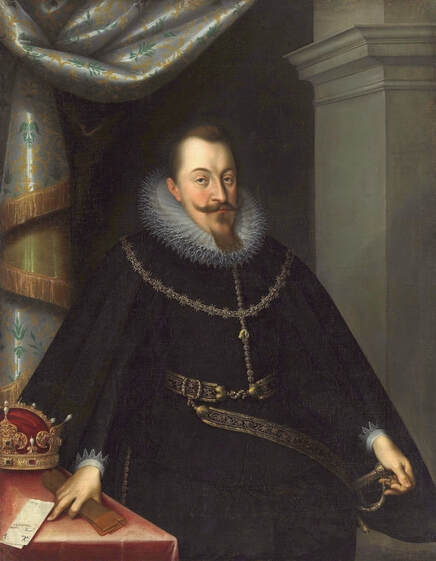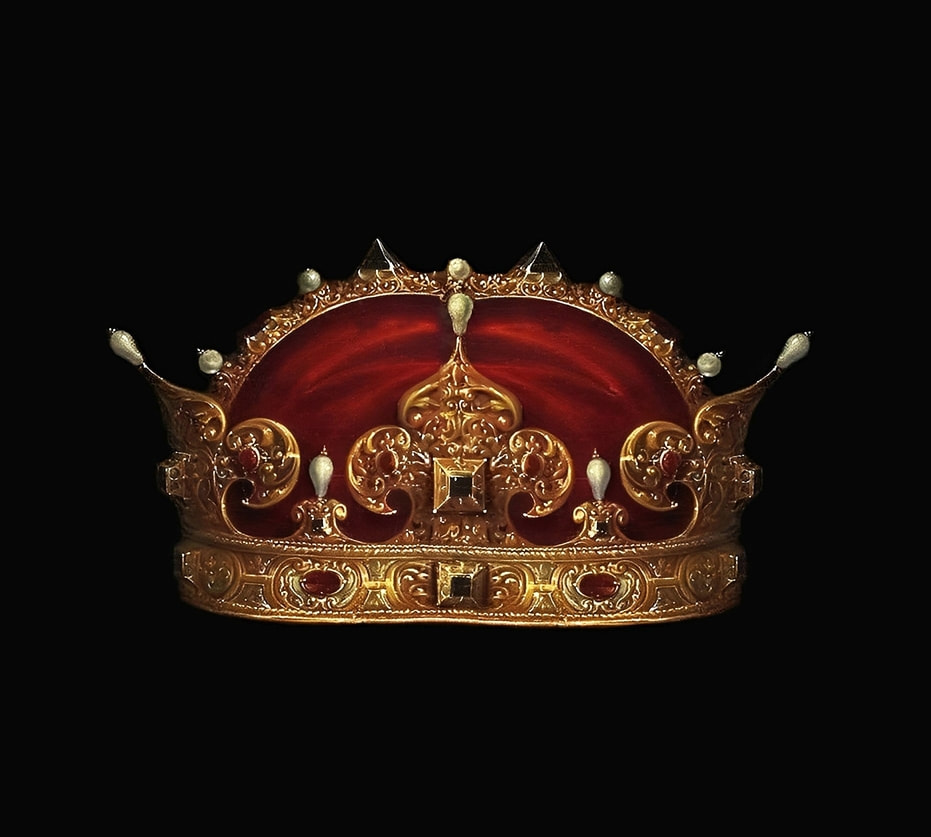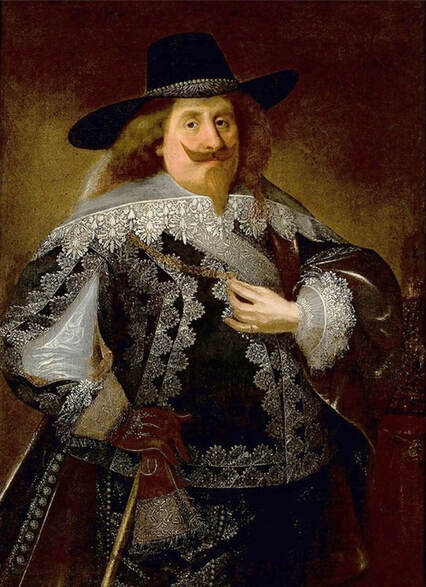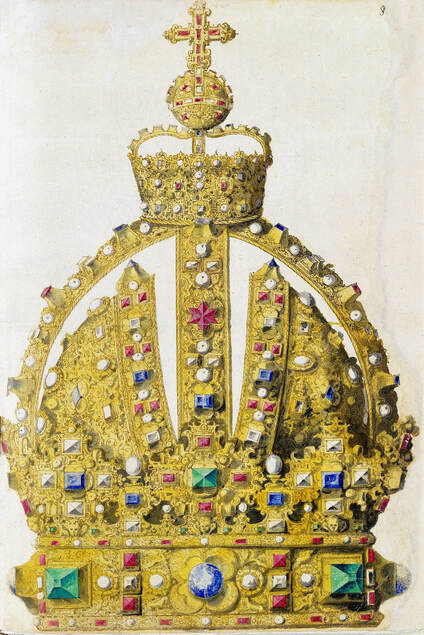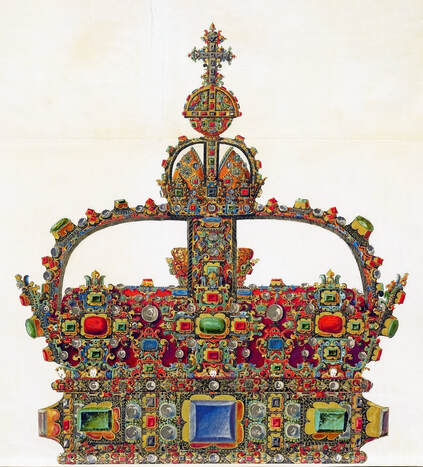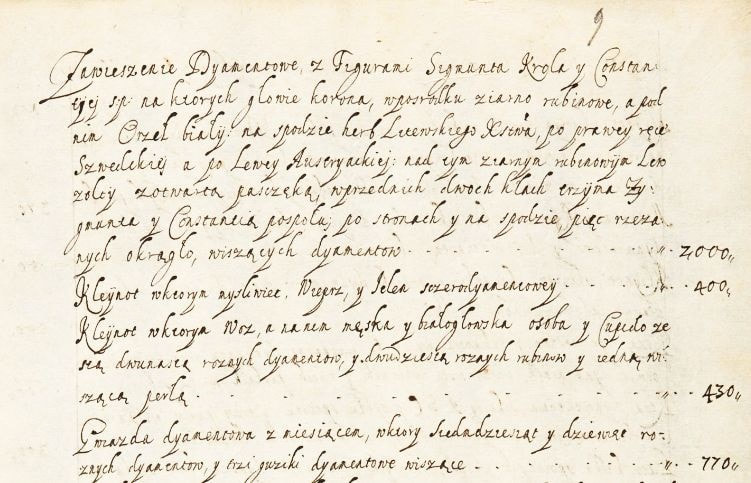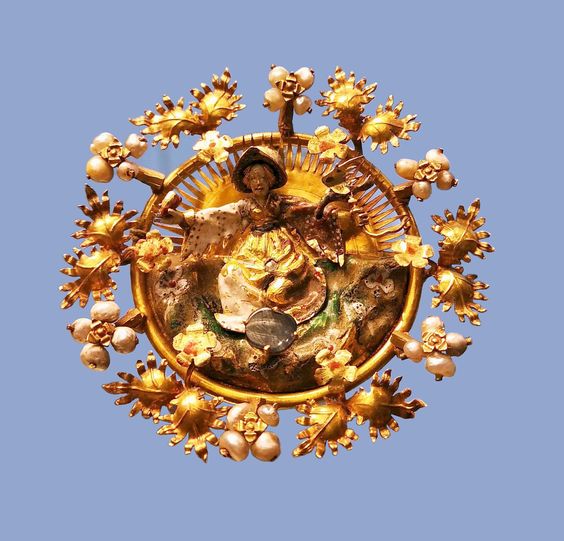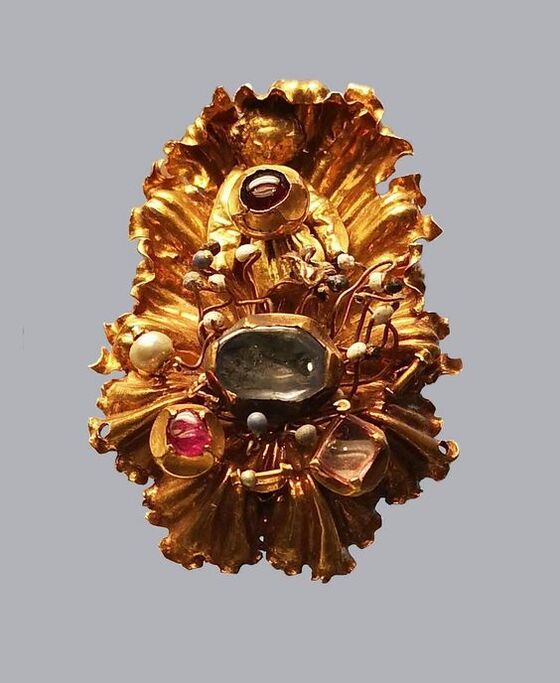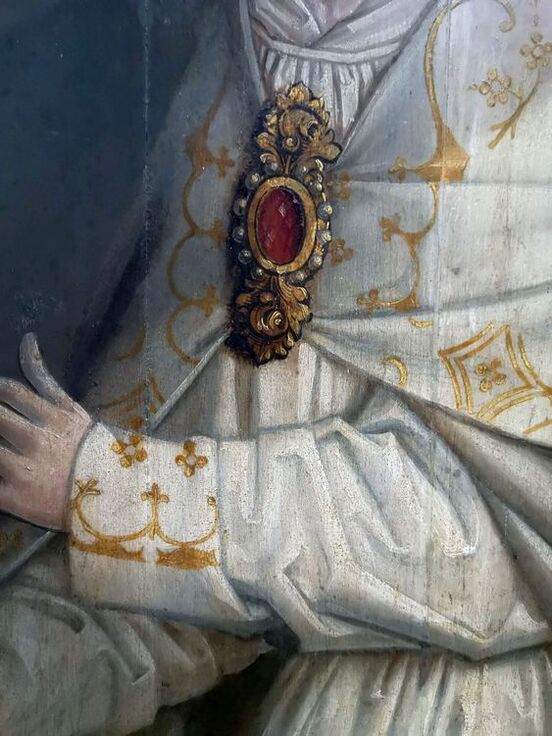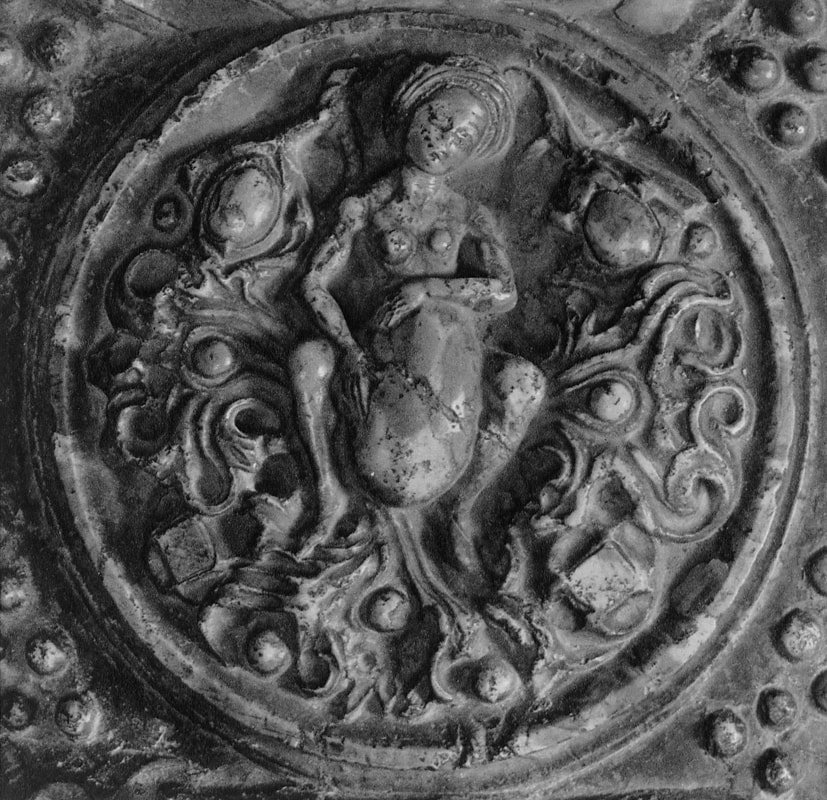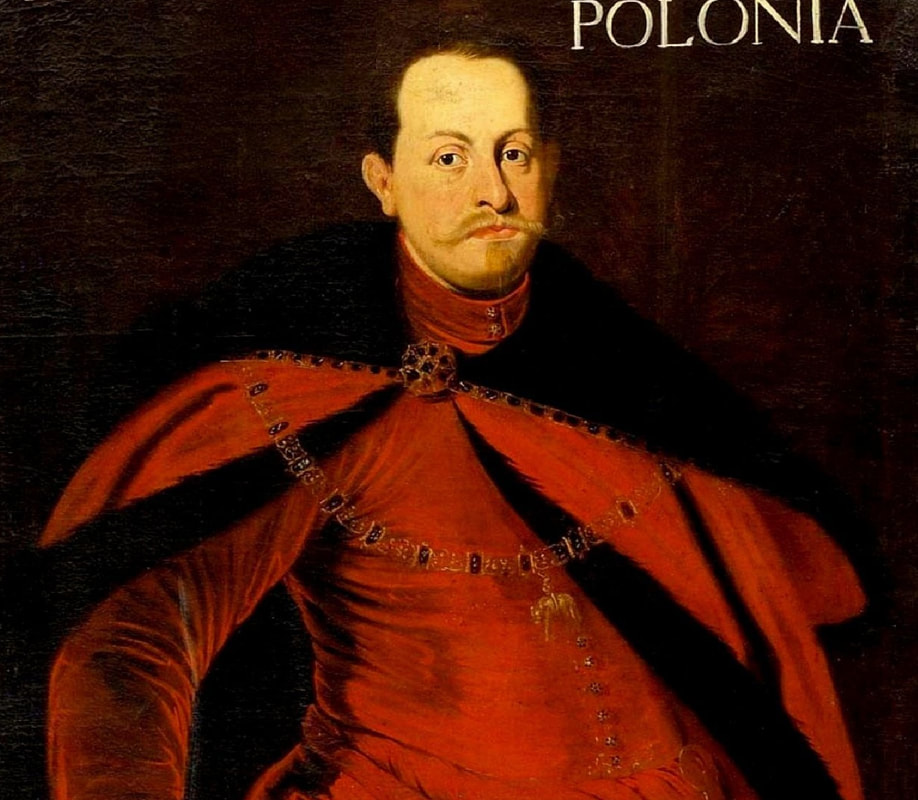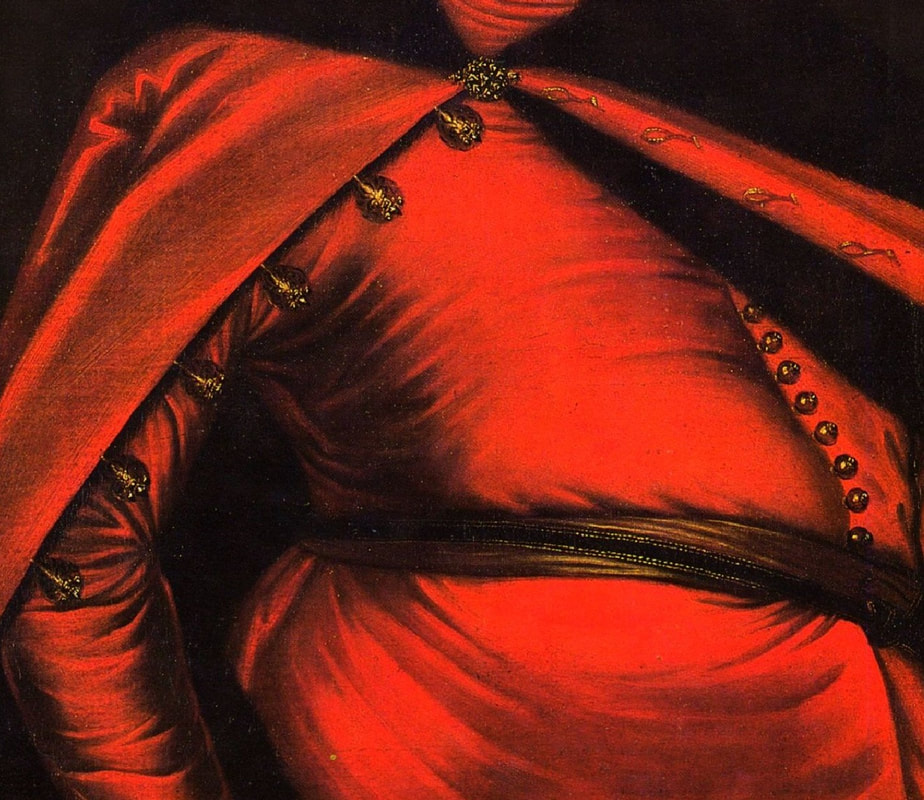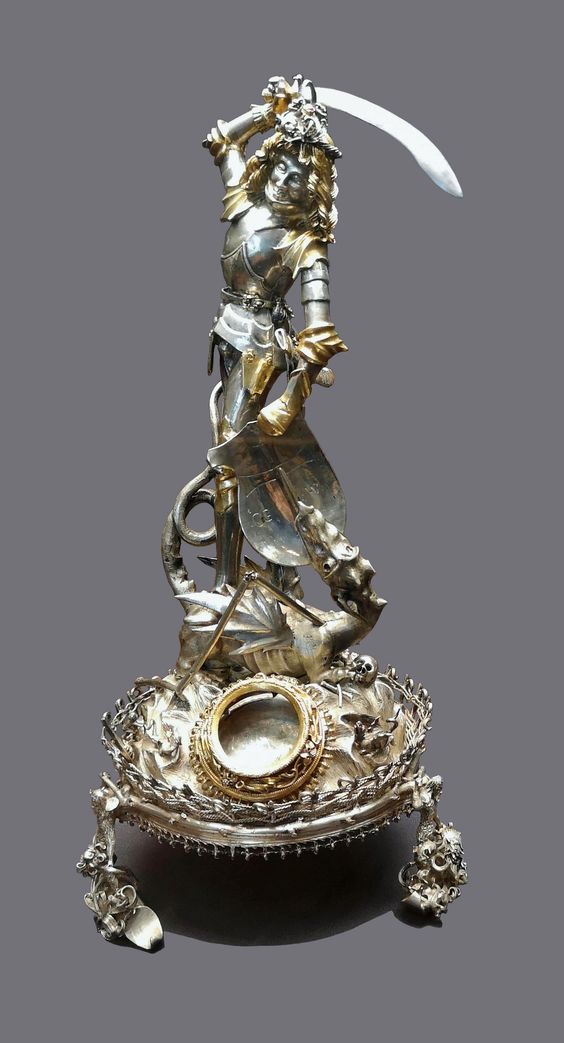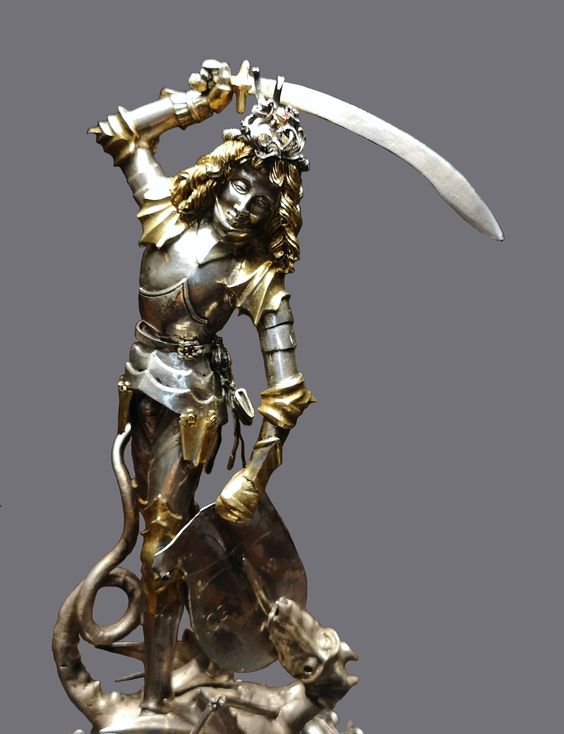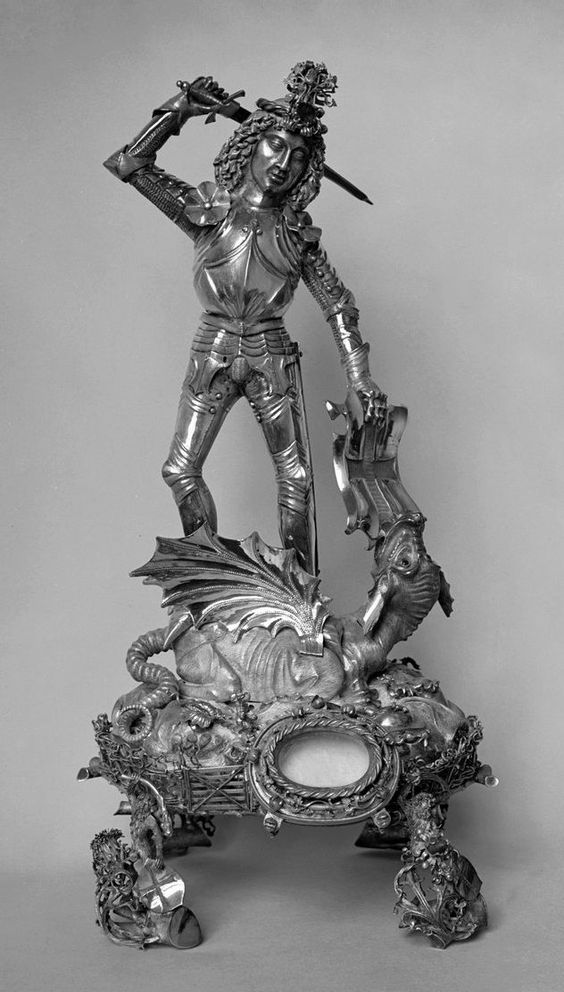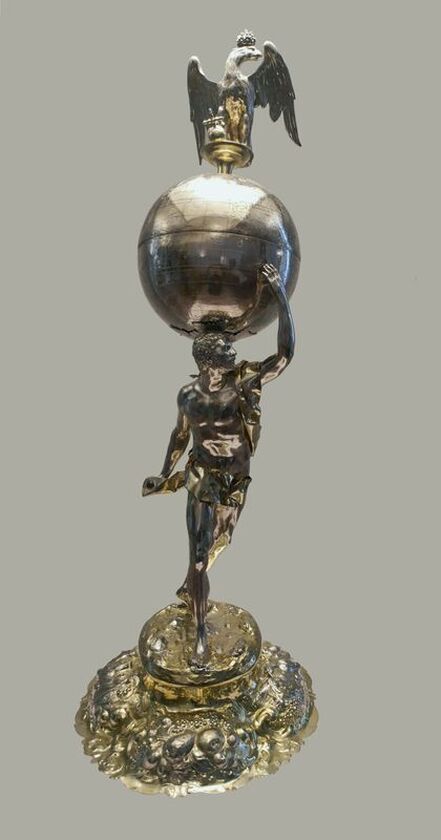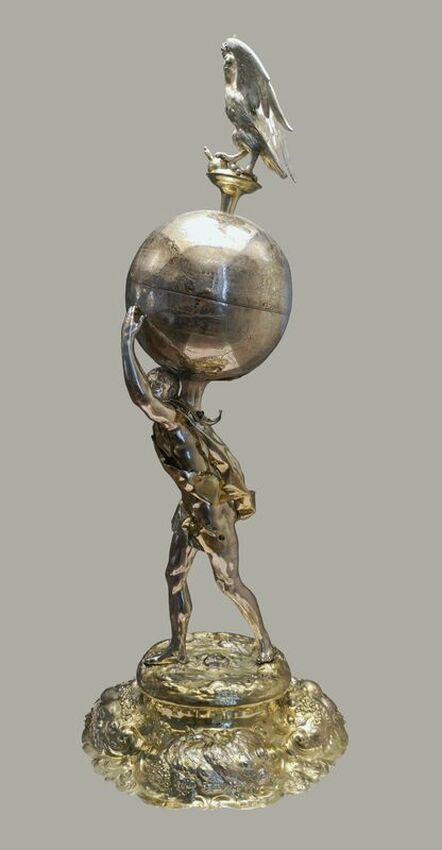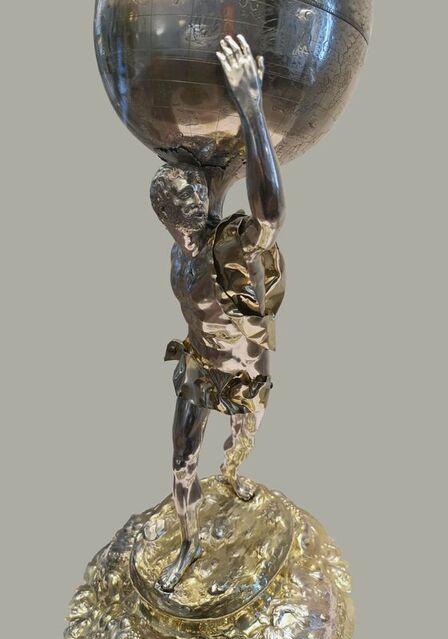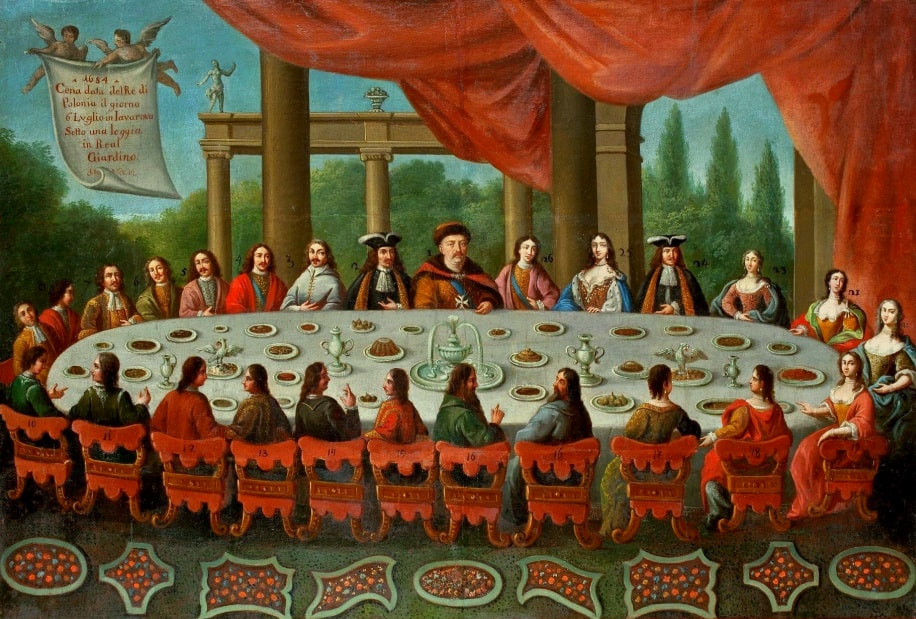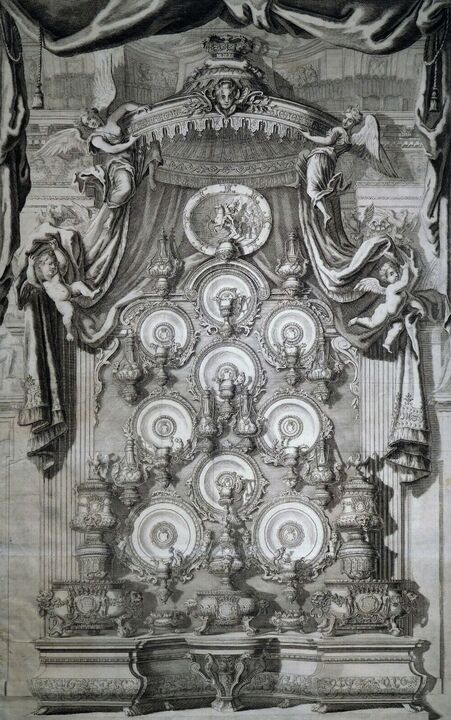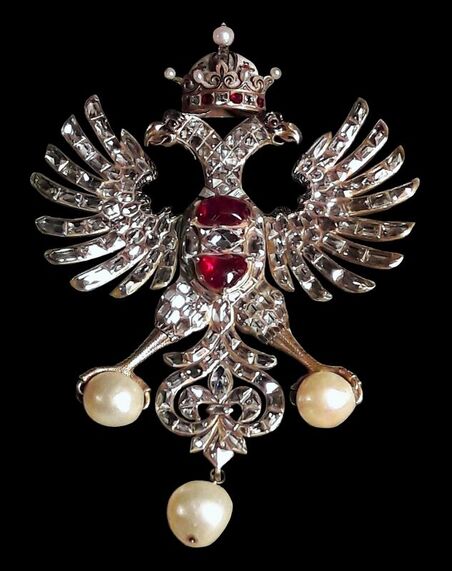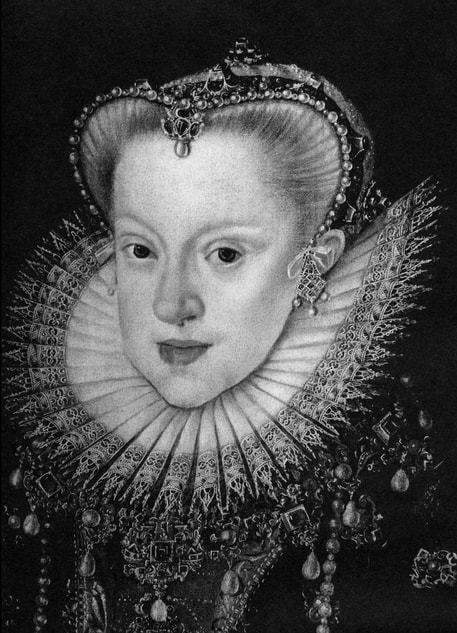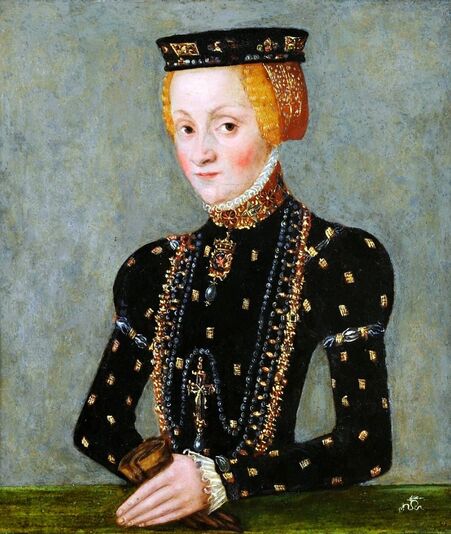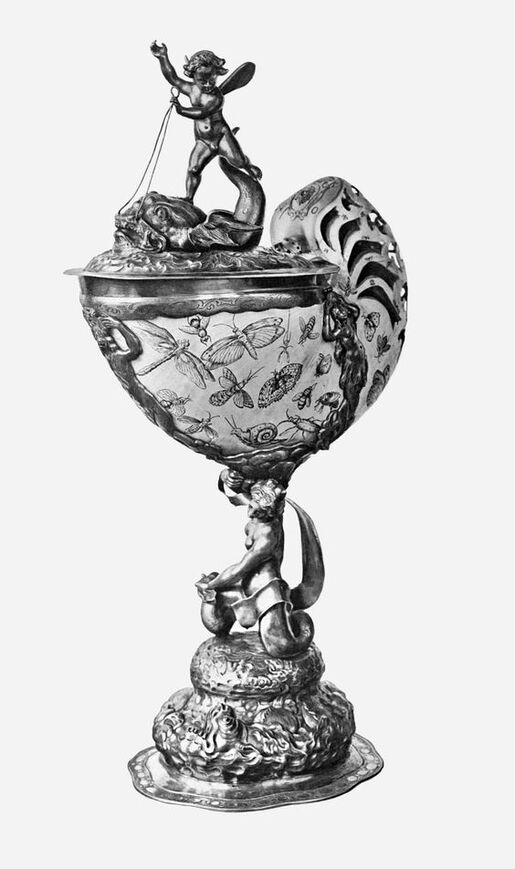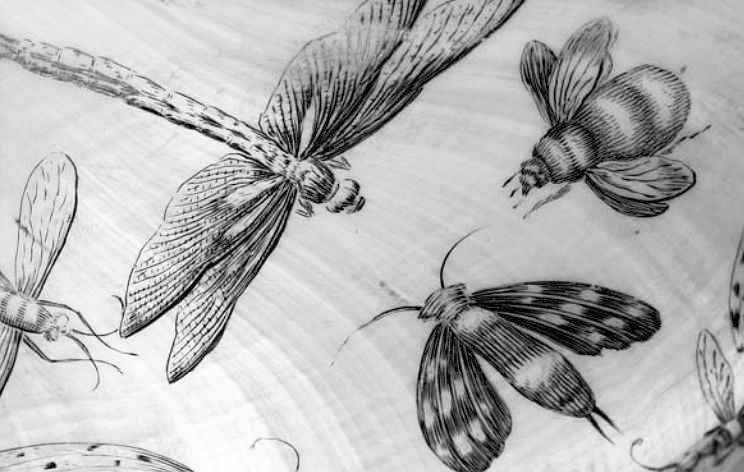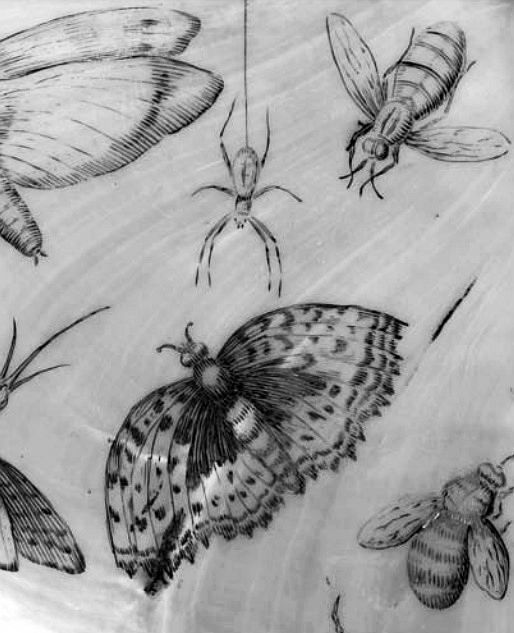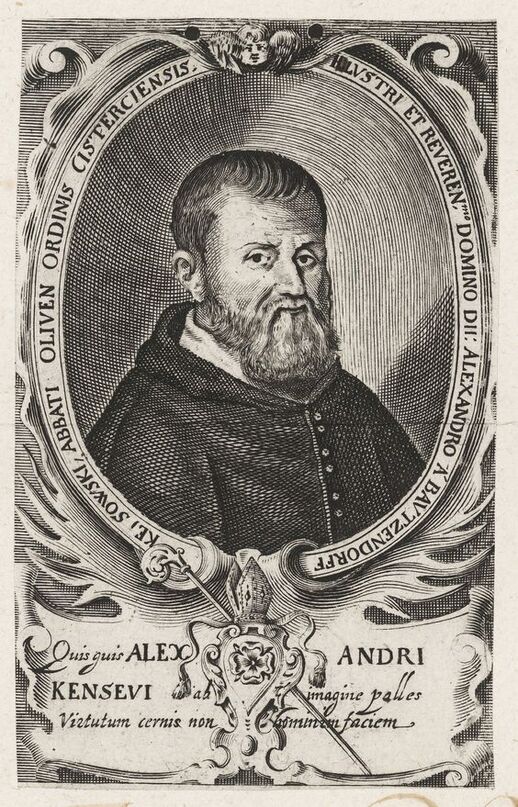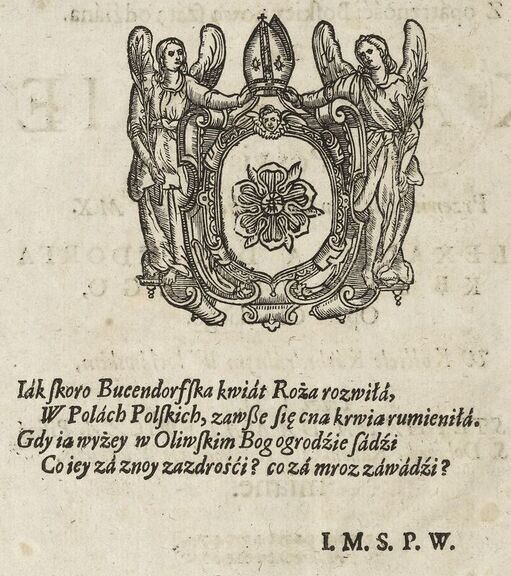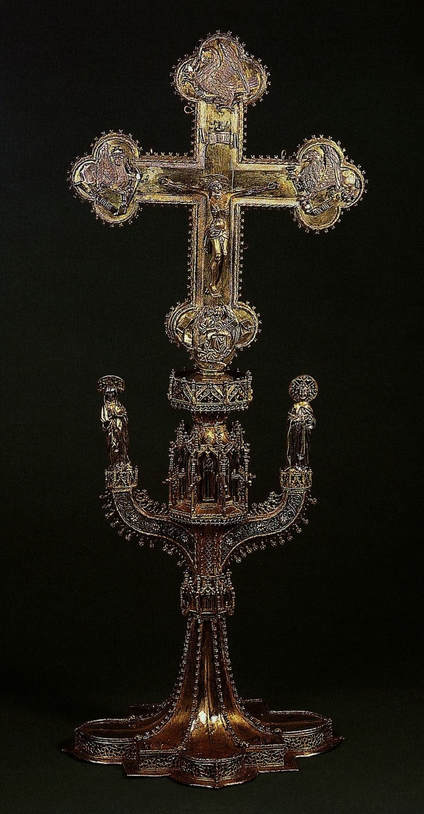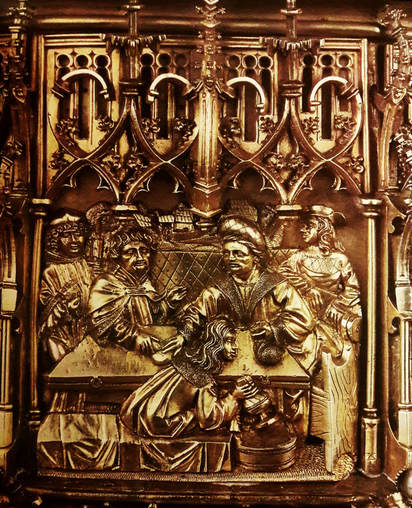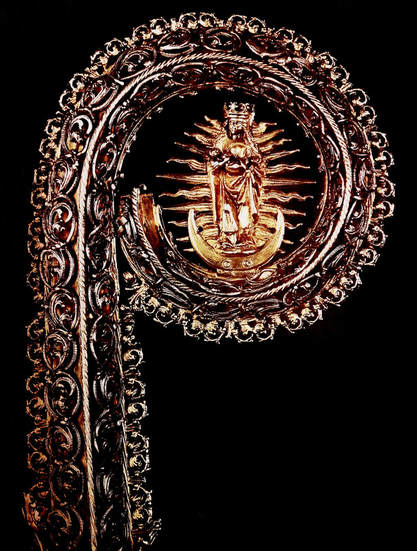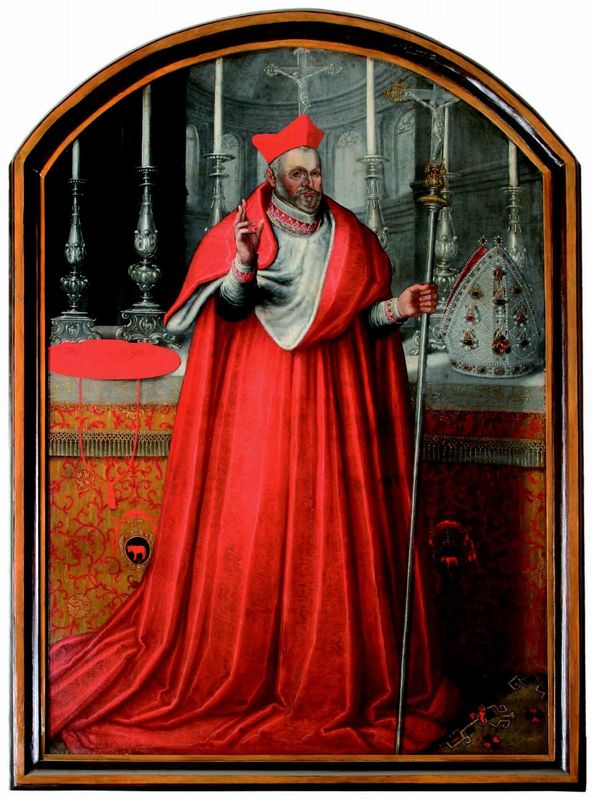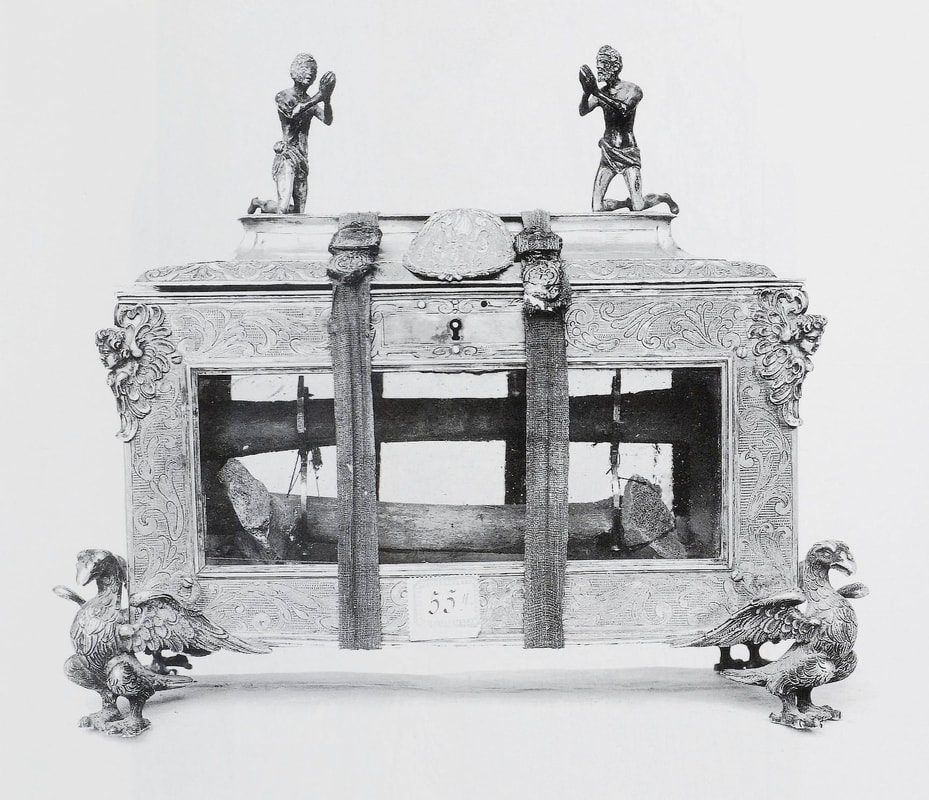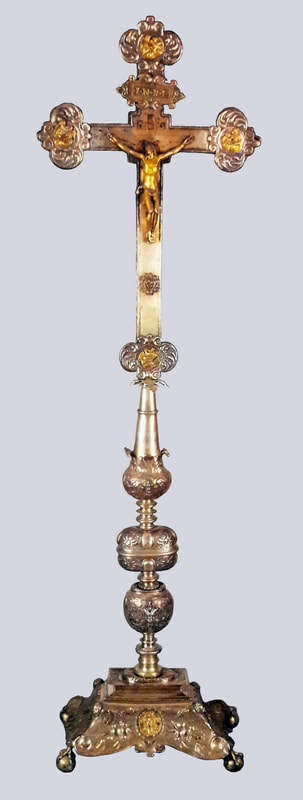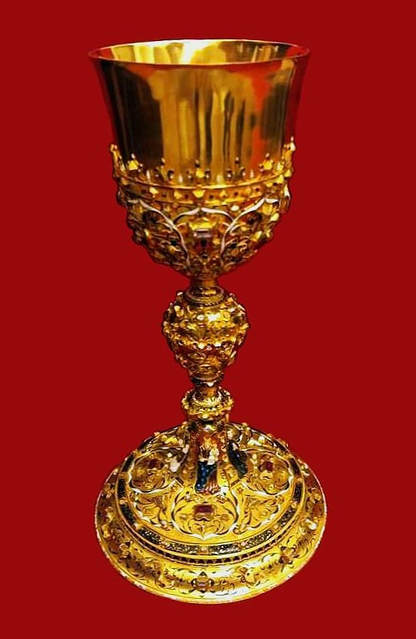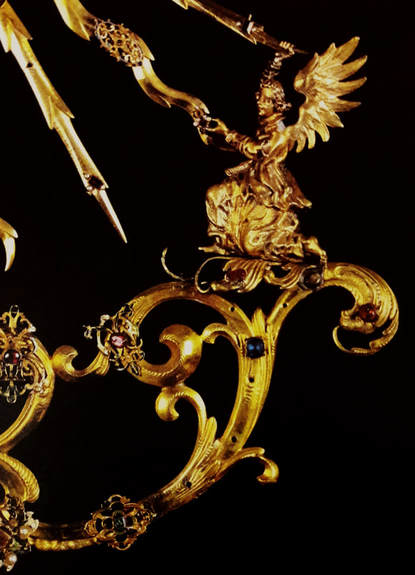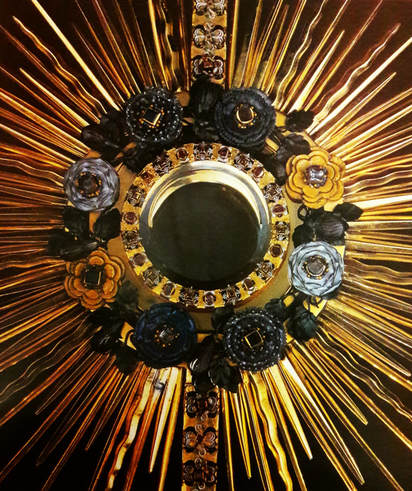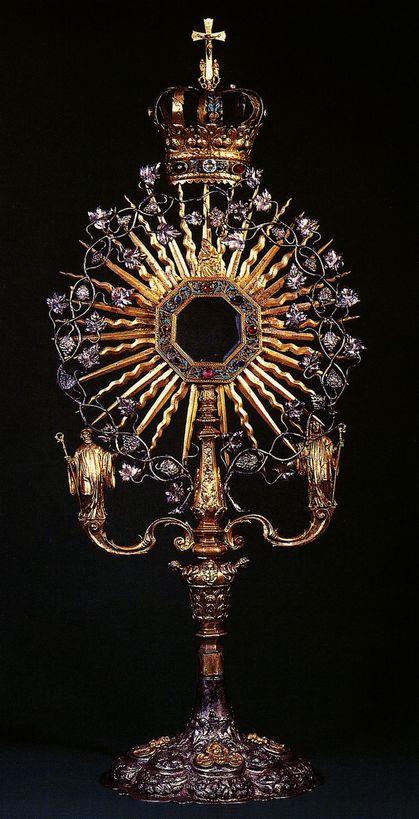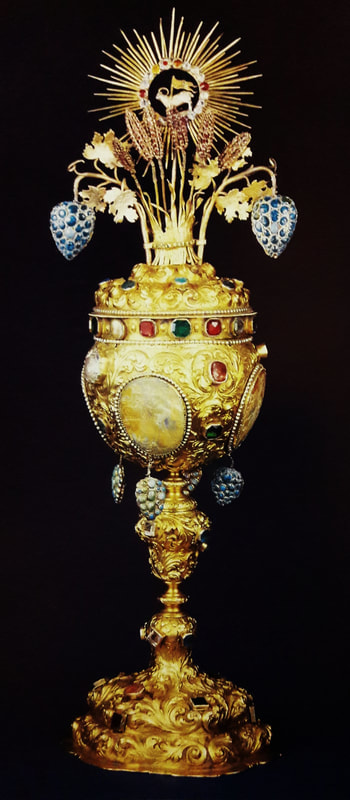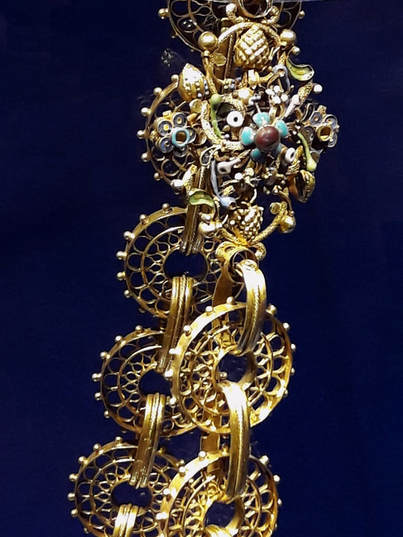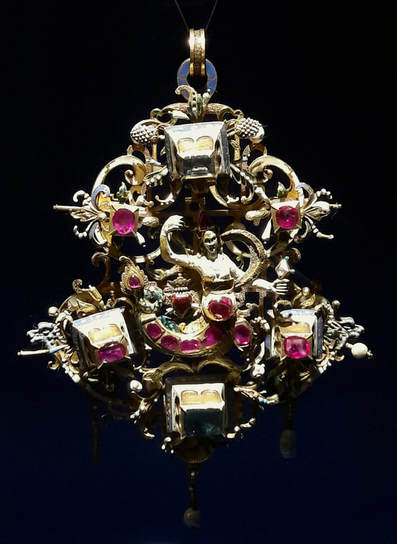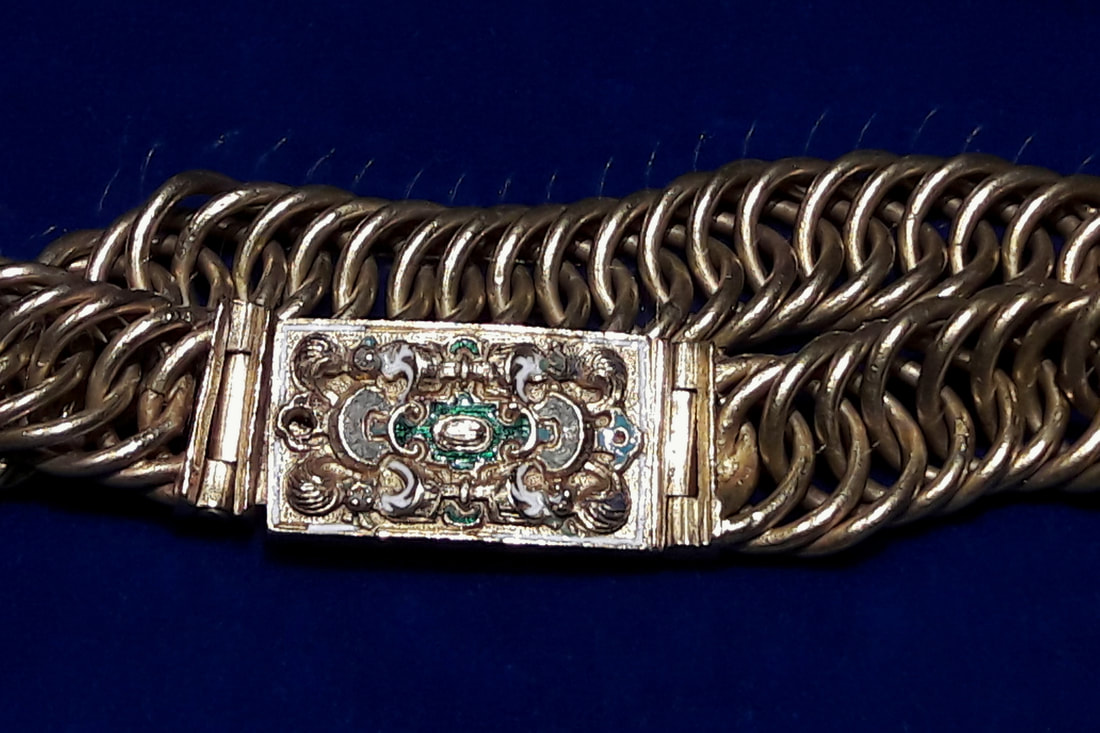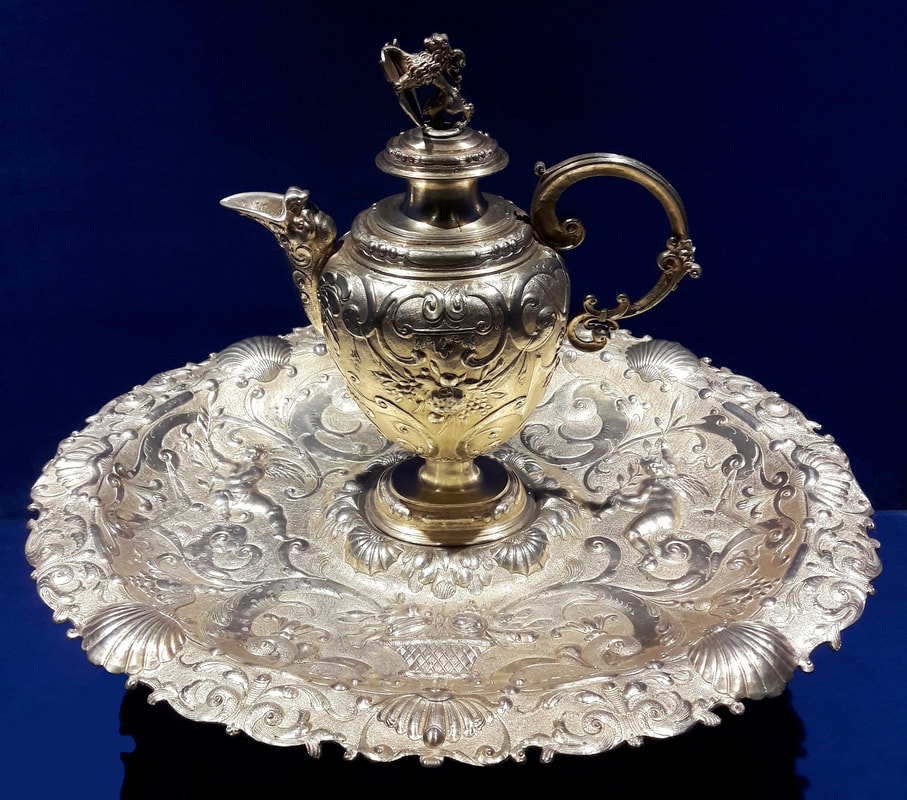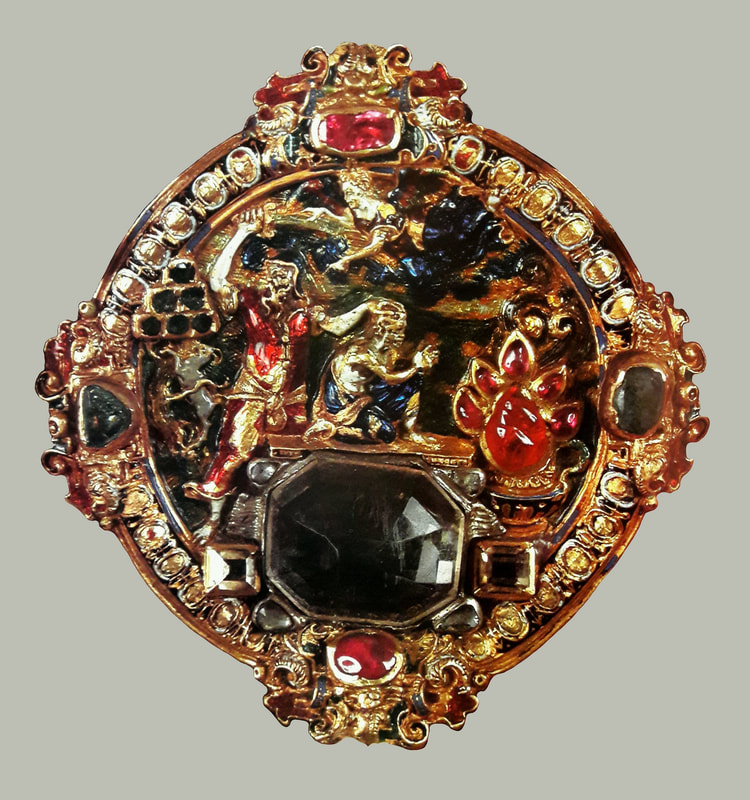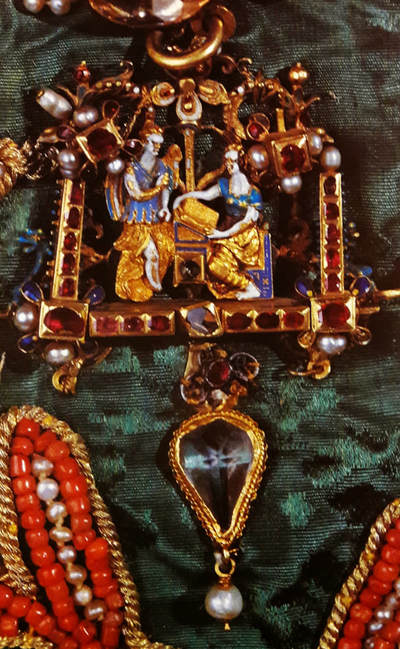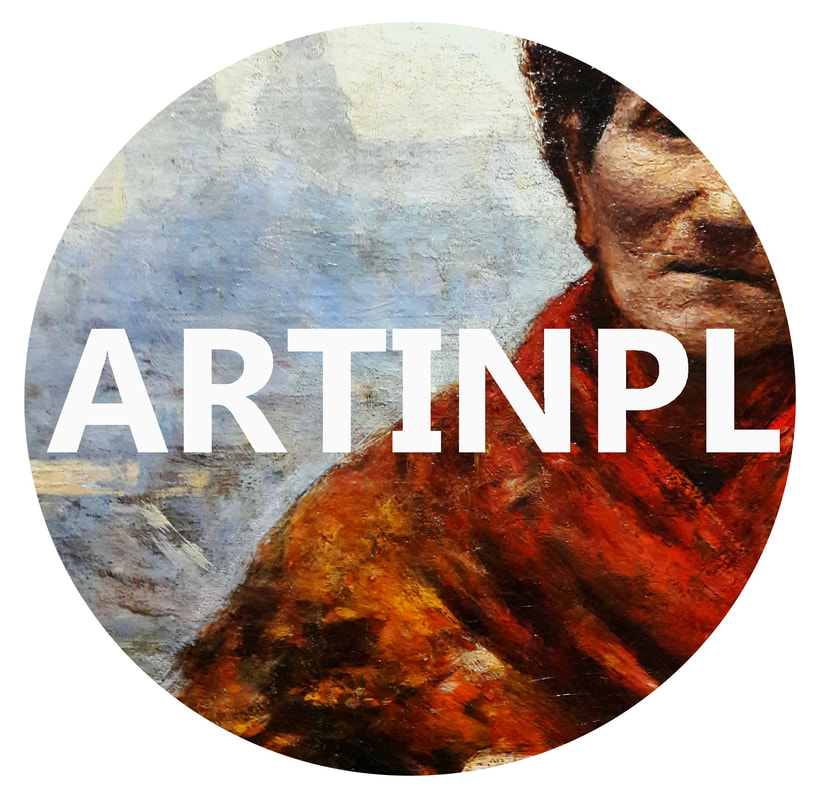|
The palace was built between 1639-1642 by Lorenzo de Sent for the Grand Crown Chancellor Jerzy Ossoliński in Mannerist style. It was constructed on the plan of an elongated rectangle with two hexagonal towers at garden side of the building. The palace was crowned with a terrace with a balustrade, above which stood the upper part of the great representative hall, covered with a spherical roof. A possible inspiration for the palace's upper pavilion and its characteristic roof was Bonifaz Wohlmut's reconstruction of Queen Anne's Summer Palace in Prague, 1557-1563.
Adam Jarzębski, styling himself as Musician of His Highness Ladislaus IV and manager of the construction of the royal palace at Ujazdów, in his "Short Description of Warsaw" (The Main Road, or a Short Description of Warsaw) from 1643, described the residence of Jerzy Ossoliński: Facade with statues of four kings, below inscriptions and a brass statue of Poland holding a sickle, with a plow and a sheaf and marble portal (2427-2435), in the middle of a building a hall covered with roof tiles with gilded brass statues in the corners (2445-2450), Elongated outbuilding with servant lodgings and a kitchen (2711-2713), stables building opposit with a gate (2720-2725), Vestibule with marble portals and iron doors of master craftsmanship (2505-2508), and a staircase with a grille and a large, solid lock (2520-2525), Large dining room (2465) with niches with statues of white marble and a brass statue of a Cupid holding a bow above the door, chandelier and tapestries (2475-2485), with a door to a wine cellar (2491) and a room with silver and gold tableware (2495-2496), Hall with upper windows and a fireplace of black highly polished marble with equestrian portrait of king Ladislaus IV Vasa on white horse against a battle scene (2527-2538), a row of family portraits by painter Hans (?) Amman, and paintings reproducing the epic tales of the ancestors, including a story of a knight wounded during a jousting tournament who was healed by Saint Anne, other stories and battle scenes, above busts of Roman Emperors of white marble (2553-2570), stucco trees in corners, most probably by Giovanni Battista Falconi, ceiling decorated with figures, animals and floral motifs and a painting depicting coronation of Queen Cecilia Renata of Austria in presence of chancellor Ossoliński, door portals of black marble with portiere tapestries with Topór (the Axe) coat of arms (2575-2600), polished marble floor (2605-2607), Lord's chambers with tapestries, French-style parade bed, tables with gold trinkets and silverware and decorative clocks beside the bed, coffers, fireplace adorned with a mosaic (2611-2632), Cabinet of curiosities in a right side tower with bronze statues of different horses, birds and people (2635-2644), silver plated cupboard-cabinet with gold inscriptions describing the contents of each drawer (2649-2652), marble table with rarities on it (2659-2662), Chapel in the left side tower with an altar with an exquisite painting, relics in glass vessels, offered by the Pope, silver coffer reliquary with bones bound by gold chains, wax miniatures, a table with a casket and a door to a staircase (2667-2692). In 1633 Ossoliński was sent with a diplomatic mission to the Pope in Rome by newly elected monarch of the Polish-Lithuanian Commonwealth, Ladislaus IV Vasa. The King offered him the starostwo of Bydgoszcz, 60,000 zlotys, six horses, a saber (scimitar) worth 10,000 zlotys, five Brussels' tapestries making up the series of the Story of Moses commissioned by King Sigismund Augustus in the 1550s, three of which were given to the Pope, and a construction site in Warsaw. An event from 1633 is also worth mentioning when Ossoliński, traveling to Rome via Veneto, fascinated by the beauty of one of the villas near Padua, ordered to immediately take its dimensions. He made his entry to Eternal City wearing a żupan, richly embroidered with gold, buttoned up with 20 large buttons with diamonds, gold sabre set with jewels valued at 20,000 Polish zlotys and mounting a Turkish stallion having golden horseshoes and a horse tack set with precious stones. In 1638 a life-size statue was cast in brass by Gerdt Benning in Gdańsk according to the design by Georg Münch for then the vice-chancellor Jerzy Ossoliński, most probably to his Castle in Ossolin. It is possible that the same workshop created statues to his Warsaw's palace. Contrary to the Crown Court Marshall Adam Kazanowski, who had a transgender man at his court, the Chancellor Ossoliński kept a transgender woman in his palace: "a boy who thinks he is a girl, and who also wears a dress: He imitates a girl quite well; especially in that, he is very eager of being cuddled", as recounted Jean Le Laboureur in his "Account of the voyage of the Queen of Poland", published in Paris in 1647 (p. 212). An engraved effigy of the Chancellor by Willem Hondius from 1648 was created after a portrait by Bartholomäus Strobel. It is possible then that Strobel created more painting for Ossoliński, including for his Warsaw's residence. In 1645 the chancellor commissioned the silver-ebony altar for the Chapel of Black Madonna of Częstochowa adorned with his coat of arms. The design was most probably by a Royal court artist Giovanni Battista Gisleni, while silver elements were created by the Royal goldsmith Johann Christian Bierpfaff in Warsaw in 1650. The "Inventory of belongings spared from Swedes and escapes made on December 1, 1661 in Wiśnicz" in the Central Archives of Historical Records in Warsaw, lists some of the preserved paintings from Chancellor's rich collection inherited by his daughter Helena Tekla Ossolińska, wife of Aleksander Michał Lubomirski, owner of the Wiśnicz Castle. 30 paintings from Chancellor's collection in the inventory include the paintings by Raphael, Titian, Guido Reni, Guercino, Domenichino, Veronese, Ribera, Albrecht Dürer and Daniel Seghers. There were also there a painting of the Leda and a swan, a gift from the Emperor, a Cupid sharpening his bow, possibly a copy of the famous work by Parmigianino, acquired in Rome, a "large Blessed Virgin Mary, a wreath around her made of fruits, which the angels holds", most probably by duo of Rubens and Jan Brueghel, and a large canvas showing Chancellor's Entry into Rome in 1633. Ossoliński died in his palace in Warsaw on August 9, 1650, at the age of 55. He was buried in the church of St. Joseph in Klimontów, which he built. His opulent palace in Warsaw was destroyed during the invasion of the Commonwealth by neighbouring countries, known as the Deluge (1655-1660).
Adam Jarzębski, styling himself as Musician of His Highness Ladislaus IV and manager of the construction of the royal palace at Ujazdów, in his "Short Description of Warsaw" (The Main Road, or a Short Description of Warsaw) from 1643, dedicated to his benefactor Crown Court Marshall Adam Kazanowski, thoroughly described the residence of this baroque celebrity.
Kazanowski gained prominence as a close friend and companion of crown prince Ladislaus Sigismund Vasa, who was elected monarch of the Polish-Lithuanian Commonwealth from 1632 as Ladislaus IV. Together with his brother, Stanisław Kazanowski, Adam was raised with crown prince and accompanied him during his attempt to become a Russian Tsar, in the Khotyn war of 1621 and the 1624 to 1625 European voyage. A breakthrough event for Adam was when his elder brother Stanisław, favourite of crown prince, attacked with syphilis was expelled from the court for promiscuity in 1620. Zygmunt Kazanowski, father of both, had great hopes for the relationship of his older son and young Vasa. Faced with the threat of his imminent death, he persuaded the sick to recommend his younger brother to the prince. Both brothers were accused by Jerzy Ossoliński in his Memoirs of organizing "suspicious" amusements for young prince. When the crown prince became king, Adam was showered with gifts and new official titles. In 1628, at the age of about 29, Kazanowski decided to get married. He chose Elżbieta Słuszczanka, a daughter of wealthy Castellan of Minsk, Aleksander Słuszko, for the future bride. The marriage meant for him not only a substantial dowry, but also valuable connections in the Grand Duchy of Lithuania. Aleksander Słuszko dismissed the suitor, justifying the refusal with his daughter's young age, as Elżbieta was then only 9 years old. However, thanks to the intervention of the crown prince, Aleksander Słuszko changed his mind. The wedding took place in the spring of 1633, when Elżbieta has reached the legal age of 14. Adam, who also became the Grand Pantler of the Crown that year, gained 50,000 zlotys of dowry. In addition, the young couple received 20,000 zlotys from the king and the value of the gifts was estimated at 40,000 zlotys. When crown prince Ladislaus Sigismund became an adolescent, his father Sigismund III Vasa bought him a wooden mansion of Andrzej Bobola at the Cracow Suburb Street in Warsaw. In 1628, shortly after his return from a journey to Western Europe, the prince ordered Constantino Tencalla a court architect to build him a new palace in the Italian style. Four yers later, in 1632, Ladislaus gave the palace to Kazanowski, which caused serious misunderstanding with his father, and a special Parliament committee was appointed to determine the circumstances behind this gesture. In 1637, Kazanowski enlarged the building, holding to Tencalla's original designs. The new structure was a large four-storied palace with a garden, enormous terrace, central courtyard, copper roofs and tower tops decorated with gilded crowns. 629 verses (1025-1654) of Jarzębski's work portray the lavish mannerist and early baroque palace constructed between 1628 and 1643 in the center of informal capital of the Commonwealth: Large arsenal filled with cannons, muskets, excellent armors, tents and turkish garments, lances and spears arranged on the walls, field guns, matchlocks and a skin of a lioness (1057-1066), Long gallery filled with paintings on both sides with nudes above the table, portraits of the King Ladislaus IV Vasa and his wife Cecilia Renata of Austria, painted Ad vivium and noble ladies, stone statue of Atlas supporting the armillary sphere on the table in the middle (1095-1108), Small arbor room adjacent to gallery with a French window, columns, stone floor and a view of the river Vistula (1121-1127), Dining room with windows on two storeys, a large chandelier with a clock showing hours, a balcony for musicians and Flemish tapestries woven with golden thread (1131-1153), chairs covered with gilded cordovan, plaques with coat of arms of the Lords and Marshals between windows in upper part and landscape paintings and cordovan in lower part, tile stove (1177-1187), window with a wine lift from basement, a large silver wine vessel of 150 litres on wheels in the shape of Bacchus wearing a wreath, sitting on a barrel and holding a goblet, several other barrels half the size of the main and a silver wine fountain in the middle of the room, silver ewers, pitchers and trays (1188-1214), the King and the Queen, envoys from Muscovy, the emperor, the king of Spain, Turkey, France and Persia were received there (1162-1171), Vaulted steam baths near the coach house with two chambers, hot stone, heating house, cold and hot water, copper bathtubs and white benches (1255-1272), Room on upper floor covered with cordovan, with a fireplace, marble portals with gold inscriptions, statues in overdoor (1305-1318) and muskets on the walls (1323), Rooms with paintings and tapestries: animalistic paintings and still-lifes with vegetables by master painters in the first, next room with staircase, seascapes and paintings of ships, casket regals, a harpsichord, a lute, a violin, cymbals, a viol and a harp and doors hung with portieres (1325-1343), next room with live animals, monkey on a chain, white parrot, singing birds in cages, still life paintings with fruits and wines, tapestries, a fireplace and a marble table (1349-1364), Lord's bedroom with a table, a painting of Adam and Eve, a bed against tapestries, good paintings, a fireplace and marble floor, a folding bench with wheels (1381-1392), trellis giving to the chapel, altar with gilded grille and a window to the ladies' room (1365-1376), Lord's study with a mirror, angels' statues holding candles, paintings, tapestries and polished marble floor (1407-1418), Library with foreign books in different languages, khanjar daggers on the table, daggers set with turquoises, gold bowls and rock crystal vessels (1425-1431), Lady's rooms, in one of them tortoiseshell caskets, pendant paintings, one with an old man with a sore eye, tapestries and looms (1437-1449), bedroom covered with goldcloth, a draped bed made of a rich fabric, mirror in silver frame above the table, the other in gold plated frame, automaton clock with a man, paintings in ebony frames, marble floor and marble table (1457-1469), a bedroom with a bed of green goldcloth with fringe and a portrait of mother of Her Majesty, Zofia Konstancja Zenowicz, in the next room in the corner of the palace a portrait of father of Her Majesty, Aleksander Słuszka, in his old age above the door, in both rooms marble fireplaces, tables covered with kilims and marble floors (1473-1495), Treasury on the groundfloor, the first room filled with guns: bird shotguns, Turkish trench guns, carabins, muskets and Italian pistols, laid with gold and silver, tables covered with Persian kilims (1508-1520), treasury room with gilded stuff set with turquoises, eastern backswords, gold sabres, gold and gilded saddles and horse tacks, sable coats, large trays and ewers in boxes and antique treasures, snake skin and a turtle from India (1530-1561), Belvedere room with grille with a view of a garden (1579-1582), wine basement with barrels of wine, mild, sweet and spicy (1590-1596), and a beer basement (1601), in the room above a workshop of Dutch painters (1603-1608), next a room with silverware (1612), and a room with hunting falcons (1613), marble pantry with venison, partridges (1641-1645) and a room of captive Muslim Tatar servants (1649-1651). Three years later, in 1646, Jean Le Laboureur, a companion of the French Ambassador Extraordinaire to Poland, Renée du Bec-Crespin, comtesse de Guébriant, visited the palace and described it in his "Account of the voyage of the Queen of Poland", published in Paris in 1647. He devoted five pages of his book to the building: Five or six large chambers and several smaller rooms, filled with silk and gold oriental fabrics, beds of gold fabric, cabinets of uncommon workmanship, tables with different items of gold, silver, amber and stones (p. 211). Large room with marble floor, as the rest of the lodgings, with a large wine fountain, made of silver in the middle, large platform above the door for the musicians, table with 80 silver-gilt Italian style tazzas (four rows of twenty each) with dried fruit, large pears in sugar, oranges, lemons, melons (p. 213), buffet with extraordinary gold and silver vessels, including Bacchus "of a natural height" sitting on a silver barrel with gold wheels, rock crystal glasses with silver-gilt mountings, Elżbieta Słuszczanka was dancing here with her brother Bogusław Jerzy Słuszka, Court Treasurer of Lithuania and marquis Gonzaga Myszkowski with his wife (p. 214). Kazanowski, struck by the sudden invasion of gout, welcomed the guests at the staircase of his palace carried in a litter (p. 210), accompanied by 300 armed guards, more than 50 pages dressed in yellow satin and short jackets of blue satin, his wife and her ladies (p. 211). In one of the chambers Le Laboureur noted "two extraordinarily small female dwarfs who were standing up like a sentry, to guard two small dogs, who were not less dwarf in their species, for they are the size of a mice, and both were resting in a white basket little larger than the hand, on a pillow of perfumed satin", while the ladies of Elżbieta Słuszczanka had a transgender man, a woman who behaved like a man, "for their entertainment" (p. 212). In 1643 Kazanowski also arranged a marriage of dwarfs, "an unheard wedding, full of laughter", according to Albrycht Stanisław Radziwiłł. Following her visit, Kazanowski and his wife, sent to Madame de Guébriant some small amber cabinets and clocks set with diamonds (p. 212). Little is known about artistic patronage of the Crown Court Marshall. Among confirmed artists at his court was certain Ezechiel Sykora, born in Litomysl in Czechia in 1622, who latinized his family name to Paritius. After Kazanowski's death in 1649 he left Warsaw and went to Silesia. As a żupnik (manager) of the Royal Salt Mines, he commissioned from Gdańsk engraver Willem Hondius in 1645 a series of views of the Wieliczka salt mine. Kazanowski had also a book of friendship (album amicorum/Stammbuch), wich was in collection of Edward Rastawiecki in Warsaw in 1853. Small oblong book bind in crimson velvet had 125 parchment leaves and majority of contributions from the years of between 1624 and 1625 of his European journey and a few from 1627 to 1644, mainly of ambassadors of the Spanish Empire. During his stay in Brussels in 1624 with the crown prince he received from infanta Isabella Clara Eugenia a gold medallion set with precious stones on a gold chain. It is possible that he intentionally tried to emulate great validos of his time, Duke of Lerma or Count-Duke of Olivares. Kazanowski died childless in 1649, leaving all his property to his wife Elżbieta. His opulent palace in Warsaw was destroyed during the invasion of the Commonwealth by neighbouring countries, known as the Deluge (1655-1660). Mannerist and early baroque royal treasures of the Polish-Lithuanian Commonwealth - reconstruction8/19/2020
Before the invasion by neighbouring countries, known as the Deluge (1655-1660), Polish-Lithuanian Commonwealth ranked among the wealthiest countries in Europe and its monarchs successfully competed with rulers of other nations as patron of arts.
"Oriental" and "Muscovy" crown of Sigismund III Vasa
King Sigismund III Vasa, elected monarch of the multicultural Polish-Lithuanian Commonwealth, was known for his refined artistic taste inherited from the Jagiellons and his grandmother Queen Bona Sforza. He commissioned the most exquisite works of art not only in Europe, but also in Persia. In 1601, the king sent Sefer Muratowicz an Armenian merchant from Warsaw to Persia, where he ordered carpets woven with silk and gold, a tent and swords from Damascus steel and other luxury items. Safavid kilims with coat of arms of Sigismund III Vasa (Polish Eagle with Vasa sheaf) preserved in many collections.
The king was so pleased with the results of Muratowicz's expedition that after his return on October 26, 1602, he gave him the title of servitoris ac negotiatoris and obliged him in the future to present all goods brought to Poland from Turkey and Persia, before they were put up for sale, at the royal court, so that he could choose those he liked the most (after "Sztuka islamu w Polsce w XVII i XVIII wieku" by Tadeusz Mańkowski, p. 25). Sigismund III had a particularly rich collection of oriental arms and Persian or Turkish kalkan shield from the Lubomirski collection in Kruszyna was, according to tradition, the property of the king (Wawel Royal Castle). Mechti Kuli Beg, Ambassador of Shah Abbas of Persia, participated in the king's wedding in Kraków in 1605 and Robert Shirley (d. 1628), sent by the shah on a diplomatic mission to European princes, was received solemnly by Sigismund at the Sejm in Warsaw on February 25, 1609. Most probably in Italy the king ordered partially gilded shishak, an oriental-style steel helmet with Hercules killing the Lernean hydra on one side and Hercules fighting Antaeus on the other as well as coat of arms of Muscovy, as a gift to Tsar Feodor I of Russia, handed over by Ambassador Paweł Sapieha in 1591 (Kremlin Museum). In Milan in Italy or in Prague he commissioned the crystal lavabo with his coat of arms and monogram (Treasury of the Munich Residence) and in Augsburg in Germany a silver service for 20,000 florins for the ceremony of receiving the Order of the Golden Fleece (used for the first time during a banquet at the Castle in Warsaw on February 25, 1601) and many other precious items. In Flanders and the Netherlands he purchased tapestries, like 6 pieces with the Story of Diana by workshop of François Spierincx in Delft, in about 1611-1615, paintings in Venice, like the Virgin and Child with St. John the Baptist and St. Stanislaus by Palma il Giovane for the St. John's Cathedral in Warsaw, before 1618, amber items in Gdańsk and Königsberg, like amber games board of Queen Anne of Denmark and other amber gifts, sent to England in 1607 through English envoy in Poland William Bruce (compare "Anglia a Polska w pierwszej połowie XVII w." by Edward Alfred Mierzwa, p. 34). The orders for works of art were related to important dates in king's life. In 1605 he spent large sums for his wedding including costly dresses emboidered with pearls. The bride was a younger sister of his first wife Anna, Constance of Austria (1588-1631), on paternal and maternal side a descendant of Anna Jagellonica (1503-1547). In July 1604, Sigismund sent letters to senators, in which he informed that Emperor Rudolf II did not give his consent for his marriage to Anna of Tyrol (1585-1618), and at the same time informed the lords of the Commonwealth of his intention to marry Constance (after "Najsłynniejsze miłości królów polskich" by Jerzy Besala, p. 169). That same year Joseph Heintz (or Heinz) the Elder, court painter of the emperor, who lived and worked in Rome, Venice, Prague and Augsburg (from 1604), created two portraits of the bride with her favourite monkey. One, less favorable, was originally probably in her family's castle in Graz (Kunsthistorisches Museum Vienna, inventory number 9452), the other in green dress, a color being symbolic of fertility, was sold in London in 1969 and later acquired by The Sterling and Francine Clark Art Institute in Williamstown (inventory number 1982.127). Many objects from the collection of King John II Casimir Vasa, Constance's son, sold in Paris, found its place in England, including most probably this portrait of his mother. Around that time Heintz created also a copy of portrait of Queen Bona Sforza (1494-1557), Sigismund III's grandmother, as Salome by Lucas Cranach the Elder (Kunsthistorisches Museum in Vienna, 862), identified by me, and a portrait of Sigismund III himself (Alte Pinakothek in Munich, 11885), signed: J. Heintzen F. / SIGISMVNDVS .../REX POLONIAE/ & SVECIAE ... on a letter on the table. The portrait of the king was before 1929 in the Schleissheim Palace near Munich, therefore it was was most probably a gift from Sigismund to William V (1548-1626), Duke of Bavaria, like the silver reliquary of Saints John the Baptist and Dionysius the Areopagite, created in 1602 for Tsar Boris Godunov and his son and given to William V in 1614 by the Polish king (Treasury of the Munich Residence, 63). The portrait shows the king with a crown, which was most probably also created around that time, possibly for the coronation of the new queen. Like the portrait, it was made either in Prague or in Augsburg, as Heintz's presence in Poland-Lithuania is not confirmed in sources. However, it cannot be ruled out that the painter or one of his students traveled to Kraków, Warsaw or Vilnius at that time to bring to Poland the portrait of the bride and the crown. Just two years earlier, in 1602, the crown of Emperor Rudolf II, a major work of European goldsmithery was made in Prague by Jan Vermeyen from Brussels (d. 1606), as a private crown for the emperor. Sigismund's crown resemble slightly the crown of Rudolf II (side view), therefore it was most probably created by the same author, nevertheless, it is in many respects atypical of Polish-Lithuanian and European monarchs in general. Unlike the crown seen in the portraits of Queen Anne of Austria (1573-1598) by Martin Kober (1595), only one rim is visible instead of two and the globe and a cross on their intersection is replaced with a pearl or a sharply cut diamond in the form evoking a pyramid, so-called diamatus punctatus. Rudolf II was depicted with his new crown in some effigies (portrait by Hans von Aachen in Apsley House, WM.1509-1948 and engraving in the State Graphic Collection in Munich, 241589D), as well as his successor Matthias (engraving by Aegidius Sadeler in the Rijksmuseum Amsterdam, RP-P-OB-5021) in which some differences with the original are visible, however, despite the fact that no other image of Sigismund's crown is known we cannot attribute it to the fantasy of a painter. Also, the overall shape of described crown is unusual and resemble more the crowns visible in Persian and Indian miniatures. Similar diadems with bent petals can be found in the investiture scene of Malik-Shah I, sultan of the Great Seljuk Empire, from the 14th-century book "Jami' al-tawarikh" (Edinburgh University Library), an illustrated leaf from a manuscript of Nizami's "Khamsa": Bahram Gur entertained in the red pavilion, created in Isfahan, Persia in the mid-17th century (private collection) or a miniature painted between 1610-1618 by Bichitr, an Indian painter during the Mughal period, and showing Moinuddin Chishti, a Persian preacher holding a globe (Chester Beatty Library in Dublin). The oriental style crown visible in king's portrait, as a private possession of the House of Vasa, was most probably melted down during the turbulent reign of his son John II Casimir Vasa, melted and material reused by Sigismund himself who was a talented goldsmith or offered as a gift to someone before 1623, as it was not mentioned in the king's last will from May 5. On May 11, 1606 the gifts from the king were presented to Tsaritsa Marina Mniszech in Moscow - 30 very valuable vessels, while the king's envoy Mikołaj Oleśnicki (1558-1629), castellan of Małogoszcz offered many pieces of jewellery "from himself and from his Wife", including "a crown with pearls, diamonds and rubies" (after "Dzieje panowania Zygmunta III, króla polskiego" by Julian Ursyn Niemcewicz, Volume 2, 1819, p. 569). The crown visible in the portrait by Heintz was also set with pearls, diamonds and rubies. It is therefore highly possible that Oleśnicki and his wife purchased the oriental crown from Sigismund as a gift for Marina. Another "oriental" insignia that entered the collection of Sigismund III Vasa around that time was the so-called Muscovy crown. This crown was supposedly sent to the king by False Dmitry after his coronation as Tsar of Russia in 1605 or it was made in Poland around 1610, after the election of Prince Ladislaus Sigismund (later Ladislaus IV), Sigismund III's son, as tsar (after "Klejnoty w Polsce: czasy ostatnich Jagiellonów i Wazów" by Ewa Letkiewicz, p. 139). Ladislaus bequeathed the crown to the Polish-Lithuanian Commonwealth's State Treasury, but after the king's death in 1648 his brother and successor John II Casimir ordered the insignia to be melted down into coins. One of the gems from the original crown became the property of Jan Kazimierz Krasiński (1607-1669), Grand Treasurer of the Crown. In the 19th century it was given to Tsar Nicholas I of Russia with a piece of parchment with the inscription in Latin EX CORONA MOSCOVIAE and found its place in the collections of the Kremlin Armoury in Moscow (inventory number ДК-752). The jewel is a double-faced sapphire icon-cameo with Christ Enthroned and Golgotha's Cross, attributed to a Byzantine artist from the 15th century. Sigismund III was depicted with the "crown taken in Moscow" on his head (after "Dzieje panowania Zygmunta III, króla polskiego" by Julian Ursyn Niemcewicz, Volume 2, 1819, p. 557) in a painting attributed to Christian Melich (Wawel Royal Castle). The painting represent the king on his death-bed displayed in the Guard Chamber at the Royal Castle in Warsaw in 1632. It was also depicted in a portrait of Sigismund's successor Ladislaus IV Vasa, attributed to Pieter Soutman and painted in about 1634, therefore created in Haarlem where the painter returned in 1628. The king was portrayed in a pourpoint lavishly adorned with laces and a high crown with a cross at the top on a table beside him (National Museum in Warsaw, 186555). Although Ladislaus was not crowned, he was officially elected and recognized as the Tsar of Muscovy in 1610 and used the title of Grand Duke of Muscovy until 1634. The crown was mentioned in Sigismund III's last will and testament made on May 5, 1623 in Warsaw as part of his successor's inheritance. The will also include "a golden basin with ewer with the Muscovy coats of arms, bought from the soldiers" left to king's wife Constance of Austria. The number of West European-style works of art and portraits connected with Tsar False Dmitry I, suggest that he purchased and ordered directly such items. His beautiful armour created between 1605-1606 in Milan by Pompeo della Cesa is in the Military History Museum in Saint Petersburg and a silver pocket watch with an eagle, possibly owned by Dmitriy, made by German or Polish workshop is in the Moscow Kremlin. At the beginning of January 1606 arrived to Kraków Jan Buczynski, secretary of the tsar, with the mission to acquire jewels for his patron. Several merchants from Kraków and Lviv, as well as jewellers Mikołaj Siedmiradzki and Giovanni Ambrogio Cellari from Milan, encouraged by the prospect of a large gain, embarked on a journey to Moscow. It was probably one of them who created the scepter (Moscow Kremlin, R-18) and orb (R-15), later owned by Tsar Michael I (1596-1645). The style of the orb resemble the mentioned crown of Sigismund III depicted in a portrait of his first wife Anna by Martin Kober. In 1606 Philip II Holbein "a court servant and agent in Augsburg" of Sigismund III, who as S.R.M. jubilerus was present in Kraków in 1605, delivered a considerable number of valuables to the court of False Dmitry I (after "Philip II Holbein – złotnik i agent artystyczny Zygmunta III ..." by Jacek Żukowski, p. 23). Holbein also worked for Emperor Rudolf II, and then - Emperor Matthias. It is possible that Dmitry's emissaries arrived also to Augsburg and Hamburg in Germany. A drawing from Album Amicorum of merchant and banker from Augsburg Philipp Hainhofer (1578-1647), who created the famous so-called Pomeranian Curiosity Cabinet (Pommerscher Kunstschrank) for Duke Philip II of Pomerania, is a copy of a painting by Szymon Boguszowicz depicting the reception of the Polish envoys by Tsar False Dmitriy I in 1606 (Herzog August Library and Hungarian National Museum). Among the designs for the crowns by Hamburg goldsmith Jakob Mores (Mörs) the Elder, who was born around 1540 and lived until around 1612 (after "Archiv Fur Geschichte Des Buchwesens", Volume 65, p. 158) in his "Jewelry book" (Kleinodienbuch, Hamburg State and University Library) there are two crowns which resemble the crown depicted in mentioned portrait of Ladislaus IV by Pieter Soutman, as well as the crowns visible in Coronation of Marina Mniszech in Moscow on May 8, 1606 by Szymon Boguszowicz or follower, created in about 1613 (State Historical Museum in Moscow). It is generally belived that these are designs for the crown of Rudolf II, however the overall shape resemble more the crowns usually associated with Russia (e.g. great imperial crown from 1762) - the "mitre" is more open then in the Rudolf's crown and there is a globe and a cross (globus cruciger) on the intersection of the rims and not a large stone like in the crown created by Vermeyen. A few years earlier, between 1593-1595 Mores created two drawings for the open crown of King Christian IV of Denmark-Norway, which were also included in his "Jewelry book". It was, however, Dirich Fyring and Corvinianus Saur, who between 1595-1596 made the crown for the coronation of Christian IV (Rosenborg Castle), nevertheless the designs by Mores resemble the shape of the final crown. Some pieces of jewellery in Poland are also attributed to Mores or his circle, like hat decorations of Francis of Pomerania (1577-1620), created in about 1600 (National Museum in Szczecin) or a chain of Constance of Austria from the 1600s (Wawel Royal Castle, ZKnW-PZS 1323), while double-headed imperial eagle from the Diamond Robe of the Black Madonna of Częstochowa also created around that time, may have been created by one of the named court goldsmiths for Constance of Austria or Marina Mniszech. The shape of the mentioned imperial insignia with a smaller crown at the top is also similar to the Cap from the Grand Set of Tsar Michael I, created by Moscow Kremlin workshops in 1627. It is also possible that the smaller crown in the "Jewelry book" is not a variant, but the insignia intended for the coronation of Marina Mniszech.
Portrait of Sigismund III Vasa with the "oriental" crown by Joseph Heintz the Elder, ca. 1604, Alte Pinakothek in Munich.
Visualization of the "oriental" crown of Sigismund III Vasa by Jan Vermeyen (attributed to), ca. 1604, © Marcin Latka.
Portrait of Ladislaus IV Vasa with the so-called "Muscovy" crown by Pieter Soutman, ca. 1634, National Museum in Warsaw.
Design for the so-called "Muscovy" crown by Jakob Mores the Elder, ca. 1605-1610, Hamburg State and University Library.
Design for the so-called "Muscovy" crown or the crown of Marina Mniszech by Jakob Mores the Elder, ca. 1605-1610, Hamburg State and University Library.
Bronze busts of Sigismund III Vasa and Constance of Austria
Although the existence of royal busts is purely hypothetical and not confirmed by sources, the fashion for such antique sculptures, stemming from Italy and Imperial court in Prague and Vienna, udoubtedly found its reflection in the cosmopolitan court of the Vasas in Kraków and Warsaw. Bronze cartouche with coat of arms of the Polish-Lithuanian Commonwealth from the Wawel Castle, a full plastic bronze cast that preserved to our days and commissioned by Sigismund III in about 1604 to adorn overdoor in the northern wing of the castle leading to the Senators' Staircase, confirms that the Vasa residences were filled with such items.
In 1624, the Bishop of Kraków, Marcin Szyszkowski, who titled himself "the most faithful servant of the House of Austria" and who together with Zygmunt Myszkowski brought the Queen Constance from Graz to Poland, sponsored a new architectural dome canopy over the reliquary of Saint Stanislaus in the Wawel Cathedral in the style of Roman baroque. It is the work of the royal architect Giovanni Battista Trevano, the same who rebuilt the Royal Castle in Warsaw, made of black and rose marble, gilt-bronze and wood, created in the years 1626-1629. Gilt bronze figures of the Evangelists and Patrons Saints of Poland, flanking the cupola over the canopy, were cast by Antonio Lagostini, active in Kraków from around 1624. In the year of completion of this work, the bishop also ordered a tomb monument for himself in the cathedral near the canopy. According to the letter from Marcin Szyszkowski to Andrzej Łukomski, a Canon of the Cracow Cathedral Chapter, of 20 January 1629, this was also commissioned from Trevano and Lagostini. The model for the cast bronze bust should be attributed to the sculptors related to Trevano, Andrea and Antonio Castelli, sculptors from Lugano, active in Kraków from about 1623. If existed, the royal busts were undoubtedly made in gilded bronze, just as majority of the similar works preserved in many European countries and Bishop Szyszkowski's bust. The material and its frequent military reuse, would also explain why the works have not preserved, as in case of bronze garden statues of Ladislaus IV's garden of the Villa Regia Palace in Warsaw, which are confirmed in sources. The preserved bronze statue of King Sigismund III at the column, so-called Sigismund Column in Warsaw, was also initially gilded. The reconstruction is based on royal portrait paintings with Spanish composition from the 1610s created by workshop of court painter Jakob Troschel, which were in the collection of the Germanisches Nationalmuseum in Nuremberg before World War II. Both effigies, possibly from dowry of Polish-Lithuanian Princess Anna Catherina Constance Vasa, are highly schematical and idealized, hence facial features are based on more realistic effigies of the royal pair created by other court painters.
Gilded bronze bust of King Sigismund III Vasa, mid-1610s to 1631. Hypothetical reconstruction by Marcin Latka ©. All rights reserved.
Gilded bronze bust of Queen Constance of Austria, mid-1610s to 1631. Hypothetical reconstruction by Marcin Latka ©. All rights reserved.
See more pictures of Bronze busts of Sigismund III Vasa and Constance of Austria on Pinterest - Artinpl and Artinplhub
Heraldic pendant of Anna Catherine Constance Vasa
Princess Anna Catherine Constance Vasa was born in Warsaw on August 7th, 1619. She was the only daughter of Sigismund III Vasa and his second wife Constance of Austria that survied the childhood and the youngest of royal pair's children.
Large Spanish style pendants, like the one described here, become less fashionable with the introduction of the French style in the mid-1630s, that prompted frontal brooches. The creation of the pendant could be then closed in the time span between mid-1620s and 1638 when Anna Catherine Constance came of age and came into possession of counties bestowed to her by the parliament. It was also probably in 1638 that Princess' portrait in red Spanish dress with two gold pendants was created (today in the Imperial castle in Nuremberg). King Sigismund III, himself a talented goldsmith, possibly stood behind the compex emblematic program of this jewel, although it is also possible that it was created long after his death in 1632. Since 1637, a marriage was suggested between Anne Catherine Constance and Ferdinand Charles, Archduke of Austria, heir of Tyrol and nephew of Ferdinand II, Holy Roman Emperor. Frederick William, Elector of Brandenburg, and Gaston, Duke of Orléans (brother of King Louis XIII of France), were also candidates for her hand. A jewel stressing splendid dynastic connections and emphasizing vastness of territories ruled by the family would perfectly fit into the Princess' situation at that time. Several heraldic jewels were featured in the official portraits of Anna Catherine Constance's mother Constance of Austria. Anna Catherine Constance's father Sigismund III Vasa was elected monarch of the Polish-Lithuanian Commonwealth, bi-federation of Poland and Lithuania ruled by a common monarch in real union, who was both King of Poland and Grand Duke of Lithuania. Since Sigismund's crowning in 1592, Polish Vasas claimed themselves rightful hereditary rulers of Sweden, consequently ignoring Sigismund's dethronement of 1598 by the Swedish parliament. Anna Catherine Constance finally married Philip William of Neuburg (1615-1690), in Warsaw on 8 June 1642. She brought a considerable dowry in jewels and cash, calculated at a total of 2 million thalers. The inventory of Princess' jewels preserved in the Czartoryski Library in Kraków summarizes their value to 443,289 1/3 hard thalers. The heraldic pendant is listed 18th in the section Pendants: A diamond pendant with Figures of the late King Sigmunt and Constantia with crowns on their heads, in the middle ruby grain, and beneath white Eagle, at the bottom coat of arms of the Duchy of Lithuania, on the right hand Swedish and on the left hand Austrian; above this ruby grain a yellow Lion with open jaw, in the front two fangs holds Zygmunt and Constantia together, on the sides and on the bottom five carved round hanging diamonds, valued at 2,000 thalers. It is hard to determine the degree of accuracy of the inventory both in terms of description of items as well as valuation. One "large diamond" in a ring was valued at 30,000 thalers and a ring with "coat of arms of Austria" was valued at only 40 thalers. Also traditionally the Queen was depited to the right and the King to the left, and not like in the description of the pendant, which finds confirmation in Sigismund and Constance's portraiture, as well as location of the royal stalls in the Cathedral of Saint John in Warsaw. The inventory also includes: A necklace of 22 parts, among which 11 with a diamond in a middle, 3 square cut, 3 triangle cut, and set with two pearls. Another 11 parts in which a Lion's head in the center having a pearl in its mouth, four diamonds and four pearls set around it. All with a pendant with sixty two cut diamonds, and on top of a Lion's head and six hanging pearls, a gift from the Queen to the Princess, valued at 80,000 thalers; A pendant in which a Lion with three crowns in the shape of the Swedish coat of arms with twenty-six different diamonds, and three hanging pearls, valued at 150 thalers and A pendant in which a white Eagle with a large ruby on the chest, three small ruby parts, and three large pearls, valued at 700 thalers. The inventory also lists A white Eagle, having a coat of arms on his cheast at which two rubies, all set with diamonds, with three hanging pearls, valued at 1,200 thalers, which is most probably identical with "diamond eagle with rubies" of the House of Austria received in 1543 by Elizabeth of Austria (1526-1545) from Emperor Charles V on the occasion of her marriage with Sigismund II Augustus of Poland, and preserved in the treasury of the Munich Residence. Among renowned jewellers of the Vasas in the first half of the 17th century, that could create the work, were Mikołaj Siedmiradzki (ca. 1550-1630) from Lviv in today's Ukraine, who was in service of Sigismund III since 1604, and who in turn employed in his workshop Mikołaj Pasternakowicz and Zygmunt Frączkiewicz. There were also Jean Barbier from Lorraine, active in Kraków from about 1605, who moved to Gdańsk in 1625 and Beniamin Lanier (d. 1630) from Vitry-le-François in north-eastern France, who was active in Kraków from 1606, both court jewellers of Sigismund III. Jakub Burnett from Edinburgh who settled in Lviv in the first half of the 17th century was employed by Ladislaus IV. Members of the family also commissioned jewels abroad, like Prince John Casimir Vasa who in 1643 paid 9000 florins for jewels to Samuel von Sorgen from Vienna and 189 florins "For diamond heart to Mr Jakub jeweller". Anna Catherine Constance died childless in Cologne on 8 October 1651 and was buried in the church of the Jesuits in Düsseldorf. It is due to purely heraldic character of the jewel, high value of the material and new fashion for more simple jewels that the pendant was most probably melted down, possibly still in the 17th century.
Excerpt from Inventory of Jewels of Her Highness Duchess of Neuburg, Crown Princess of Poland (Spisanie Kleynotów Xiężney Iey Mości Neyburskiey, Królewney Polskiey) by Royal Chancery in Warsaw, 1645, Czartoryski Library in Kraków. Fragment describing Heraldic pendant of Anna Catherine Constance Vasa.
Heraldic pendant of Anna Catherine Constance Vasa, mid-1620s to 1638. Hypothetical reconstruction by Marcin Latka ©. All rights reserved.
See more pictures of Jewels of the Polish Vasas on Pinterest - Artinpl and Artinplhub
Tapestries with Story of Odysseus
During his stay in Antwerp in 1624, the Crown Prince of the Polish-Lithuanian Commonwealth, Ladislaus Sigismund Vasa visited Peter Paul Rubens' workshop, admired Jan Brueghel the Elder's paintings and visited the famous art collection of Cornelis van der Geest. He also went to see the tapissierspand (Tapestry house), on the site of the current Bourla Theater, on September 24, 1624. We visited a house, writes Stefan Pac, in his diary where they sell beautiful and precious tapestries that are sent all over the world. A few days later, on October 5, 1624 Gaspard Nagodt, treasurer of the Prince of Poland, signed a contract with a Brussels' weaver Jacob Geubels the Younger for delivery of ten tapestries representing the Story of Odysseus (Ulysses) of six ells height each (Flemish ell was equal to about 70 cm or 27 inches), interwoven with gold and silver thread. The complete set comprised 594 ells and cost 19,008 florins. On October 12, 1624 another contract was signed for a series called "with greenery" i.e. verdure tapestries or "Landscapes and Bocages in fresco", for 9207 florins.
An Antwerp merchant, Jan Bierens, "agent and domestic of His Highness the Serene Prince Wladislaus Sigismundus, Prince of Poland and Sweden", oversaw the weaving of the tapestries of the Story of Odysseus and verdures that Geubels the Younger made in Brussels. A lawsuit brought by Geubels against Jan Bierens in December 1626 for payment, confirms that at least a part of the commissioned tapestries was ready by this date. Notations in the archives reveal the existence of the prince's agents, such as mentioned Jan Bierens and Georges Deschamps or the Frenchman Mathieu Rouault. They had to satisfy Ladislaus Sigismund's creditors and ensure that everything was executed and sent to Poland. Probably due to Prince's financial difficulties the whole set not executed till Geubels' death in 1629 and the commission was accomplished by an unknown workshop. It is uncertain when the Story of Odysseus and verdure tapestries were dispatched from Antwerp and when they arrived in Poland. Ladislaus Sigismund, the newly elected monarch of the Commonwealth as Ladislaus IV, wanted to have them before his coronation on February 6, 1633 in Kraków. By a notarial deed of January 12, 1632 we learn that Jan Bierens had received three chests containing approximately two hundred and fifty - three silver marcs from the hands of Francesco Gissa and Joannes Curius, one butler and the other secretary of Abbot Mikołaj Wojciech Gniewosz (d. 1654), Ambassador of the Polish-Lithuanian Commonwealth. The Antwerp merchant had given them two thousand three hundred and ten rixdales as a pledge and had promised to send the precious delivery to Gdańsk to the address of Abraham Pels. In the letter from September 15, 1632 Ladislaus IV asked Christian IV of Denmark to release his tapestries from customs (Rkps Riqsarkivet, Polen A. I, 3). According to François Mols, a number of tapestry cartoons by Jacob Jordaens with the date 1620 were sold at Antwerp in 1774. It is belived that these tapestries were inspired by knowledge of Primaticcio's lost frescoes of the same subject at Fontainebleau. A document from May 15, 1656 in the archives of Antwerp in which Jacob Geubels, son of Jacob Geubels the Younger, had undertaken to weave, tapestries representing the Story of Ulysses after cartoons by Jordaens, confirms that the series were made to his design. Lavish tapestries "hang up in foreign style" among "golden Netherlandish arts" are mentioned in Adam Jarzębski's "Short Description of Warsaw" (The Main Road, or a Short Description of Warsaw) from 1643, as adorning Ladislaus IV's Palace Villa Regia in Warsaw (1950-1956). The series was inherited by Ladislaus' brother John II Casimir, who took them to France after his abdication in 1668 and was sold on auction in Paris in 1673 to the agent of the Charles I Louis, Elector Palatine for 12,000 French pounds (position 728 of the inventory).
Tapestry with Odysseus threatening Circe by workshop of Jacob Geubels II after cartoon by Jacob Jordaens, 1624-1632, with coat of arms of the Crown Prince of the Polish-Lithuanian Commonwealth, Ladislaus Sigismund Vasa, the mark of the city of Brussels B B, weaver's monogram and signature IACO GEVBELS. Hypothetical reconstruction by Marcin Latka ©. All rights reserved.
See more pictures of the Villa Regia Palace in Warsaw on Pinterest - Artinpl and Artinplhub
Medieval collection of the Museum of Decorative Arts in Berlin holds three important treasures connected with Poland.
When in 1392, the city of Lublin received a trade privilege from king Ladislaus II Jagiello, it developed into a trade centre, handling a large portion of commerce between Poland and Lithuania. Under the rule of the Jagiellon dynasty the Lublin castle enjoyed royal favor and frequent stays by members of the royal family. Two gold brooches in Berlin are tokens of the city’s prosperity thereafter. The first one with a lady hawking, adorned with enamel, and set with a sapphire and pearls is 7.5 cm in diameter (inventory number F 1364). It came through the Albert Figdor’s collection in Vienna into the possession of the Berlin museum. According to the catalogue of the Figdor’s collection, it was found in the ruins of the Konopnica castle near Lublin. This information is not very accurate, since there was no castle in Konopnica and the only old ruins in the village are those of a church campanile from 1781, although the document from 1428 confirms the existence of the Saint Catherine’s church there. It is possible that the jewel was lost or hidden by its owner in the church. This owner could be certain Jan Chmielowski, tenant of the village of Konopnica, whose bad management led to a peasant revolt between 1615 and 1616 and who died during this time. He is noted for his taste for Eastern garments and as owner of 10 stylish ferezja (overcoat of eastern origin lined with fur) valued from 12 to 30 zlotys. Such coat, as well as another very popular delia, was pinned together or adorned with a clasp or brooch and had decorative fastening by buttons. Around that time Florian Ważyński (d. 1617) had in his ferezja coat “two large pearl buttons” (dwa wielkie perłowe guzy). The second brooch with a shield bearer is also adorned with enamel and set with gemstones and pearls, a height of 6.5 cm and a width of 4.5 cm (inventory number F 3515). It was discovered as part of a gold hoard in 1836 in Abramowice, now part of Lublin, by men working in the courtyard of a manor house there and was dispersed among them. The owner managed to retrieve a gold brooch, three gold rings, two buckles and some ducats of king Matthias Corvinus. The brooch was sold to Mrs Maria Strojnowska owner of Dominów near Lublin and later acquired by the Berlin museum. The first mention about the manor house in Abramowice comes from the Liber beneficiorum of Jan Długosz from 1393 and tells about the owner of the knight's farm - Sieciech (Sethegius), and then - Andrzej and Jan Klimuntowski of the Topór coat of arms. At the end of the 15th century, Abramowice belonged to Jan Ossoliński, who pledged his property for 250 Hungarian florins to the Lublin judge Mikołaj Pszonka, one of the founders of the Babin Republic. The current manor was built in 1790 for Ewa née Gałęzowska and her husband Stanisław Kossowski. A note in Liber colloquiorum from 1447, that Mikołaj Michałowski, castellan of Kraków had moniliorum alias clasp et torqvis alias pendant with pearls (moniliorum alias zaponicze et torqvis alias noszenye de margaritis) of 700 florins worth, and the inventory of the state jewels from July 1607, which lists a clasp with a ruby rose adorned with pearls and other jewels, 9 different diamond clasps with Saint George, one with king David holding Goliath’s head and a clasp with Vulcan made of white enamel sitting on a three-facet cut diamond, confirms the taste for exquisite jewels in Poland from the medieval times. Stylistically and due to technique of encrusted enamel used to decorate both brooches, they should be attributed to French or Burgundian workshops, although it cannot be excluded that at least one of them was produced locally.
Gold enamelled and gem-set brooch with a lady hawking found in Konopnica near Lublin by Anonymous from Burgundy or Paris, early 15th century, Museum of Decorative Arts in Berlin.
Gold gem-set brooch with a shield bearer found in Abramowice near Lublin by Anonymous, early 15th century, Museum of Decorative Arts in Berlin.
Detail of Annunciation, right outer panel of Crucifixion Triptych of the canon Peter von Wartenberg (Piotr z Sycowa) by Wilhelm Kalteysen, 1468, National Museum in Warsaw.
Brooch from the coronation mantle with a woman giving birth, fragment of tomb monument of King Casimir IV Jagiellon by Veit Stoss and Jörg Huber in Kraków, 1492-1496, Wawel Cathedral.
Detail of portrait of Prince Ladislaus Sigismund Vasa in Polish costume by circle of Peter Paul Rubens, 1620s, Pitti Palace in Florence.
Detail of portrait of Jakub Sobieski by Anonymous, ca. 1643, Lviv National Art Gallery.
The reliquary holding a capsule for the presentation of the relic in its pedestal with Saint George fighting the dragon is one of two similar vessels from Elbląg in Prussia, the city which come under the sovereignty of the Polish crown in 1454. Both containers were created in the third quarter of the 15th century, most probably around the year of 1475. The one in Berlin was found in a niche of the church of Saint George in Elbląg, where it had been walled in 1564 or in about 1520. It was discovered in 1652 and then given to the Epiphany church in Elbląg. In 1773 the superior of this church, Christian Gottlieb Wulff, acquired the reliquary for the sum of 55 thalers. In 1876 it was cleaned and restored by Elbląg’s goldsmith Emil Höpner for the current owner Ferdynand Kamiński, the court councilor of Elbląg. Two years later, in 1878, the vessel was offered by Albert Katz from Zgorzelec to the Berlin museum (inventory number 1878,618). Saint George on a base, holding a Hungarian-Turkish type sword, is 30.5 cm high and weighs 957 g. The second, similar container, today in Hamburg, was commissioned by the St. George’s Brotherhood in Elbląg for this saint's altar in Saint Nicholas church in Elbląg. In the second quarter of the 16th century it was put into storage in the City hall and discovered there in 1773 in the basement. Then sold on auction, it returned to the St. George’s Brotherhood in 1811 where it was kept untill 1945. In 1950 the second reliquary was given by Philipp F. Reemts to the Hamburg Museum of Art and Design (inventory number 1950.31). The Hamburg vessel is larger with 46 cm high and weighs 2370 g and is adorned coral, amethysts and rubies.
Just as later reliquary of Saint George created for the Brotherhood of Blackheads in Riga in 1507, the containers from Elbląg are attributed to the workshop of Bernt Notke in Lübeck or Israhel van Meckenem, whose print from mid-15th century could be a model for Elbląg works, although it cannot be excluded that all of them were created by local workshops.
Silver-gilt St. George's reliquary from Elbląg by Anonymous (Bernt Notke in Lübeck?), ca. 1475, Museum of Decorative Arts in Berlin.
Fragment of silver-gilt St. George's reliquary from Elbląg by Anonymous (Bernt Notke in Lübeck?), ca. 1475, Museum of Decorative Arts in Berlin.
Silver-gilt St. George's reliquary from Elbląg by Anonymous (Bernt Notke in Lübeck?), ca. 1480, Museum of Art and Design in Hamburg.
On June 17th, 1696 died in the Wilanów Palace in Warsaw after 20 years reign, John III Sobieski, elected monarch of the Polish-Lithuanian Commonwealth. Shortly after king’s death an inventory of his belongings in the palace was opened. The document contains 122 positions of exquisite silverware, some of which could be created for 20th anniversary of king’s coronation on February 20th, 1696. In the part of royal treasury supervised by burgrave Brochocki, there was "a silver pyramid with 11 baskets made in Augsburg (No. 9.)", "a silver bowl made in Augsburg with a cover with phoenix (No. 4.)", "a three storey fountain with gilded elements made in Augsburg (No. 8.)" and "partially gilded service made in Augsburg with salt cellars, trays, vinegar cruets, bowls and Hercules in the center (No. 7.)". According to inventory the latter service had total weight of 56 grzywnas and 12 łuty, while the Kraków grzywna, used in Poland after 1650 weighed 201.86 g, therefore total weight of the service was approximately 11,304.16 g. Similar vessel from the Green Vault in Dresden (inventory number IV 292), created in 1617 in Nuremberg by Heinrich Mack and Johann Hauer, meaure 75 cm with 4686 g weight.
The inventory also lists some gifts from foreign monarchs including gold bowl offered by Elector of Brandenburg (till 1657 a fief of the Commonwealth as Duke of Prussia) - “gold bowl in the shape of a shell presented by Elector of Brandenburg with his coat of arms” 894 red zlotys worth, inherited by prince Aleksander Benedykt Sobieski. On March 24th, 1712 arrived to Berlin, a capital of newly created Kingdom of Prussia (earlier Brandenburg), an envoy of the Polish-Lithuanian Commonwealth and Saxony, count Jacob Heinrich von Flemming. His mission was to negotiate alliance against Sweden (diplomatic credentials for Flemming, Dresden March 17, 1712 [O. S. A. Rep. XI: 247 ii Fe. 55]). Both Prussia and Sweden, growing military powers in the region, pose a significant threat to the Commonwealth. Prussia claimed Courland, a vassal Duchy of the Commonwealth, Varmia and Elbląg, while Swedes were even more perilous for elected successor of John III Sobieski, Augustus II the Saxon, called the Strong, as they supported Stanislaus Leszczyński, a candidate to Commonwealth’s crown and Augustus’ rival. The king was prepared to make far-going territorial concessions to alleviate Prussia and the envoy undoubtedly has not arrived barehanded. It is possible then that Augustus has sent from Warsaw a part or whole silver service made for Sobieski, as a gift. Table centerpiece with Hercules carrying the terrestrial globe and royal eagle in the Köpenick Palace, a branch of Museum of Decorative Arts in Berlin (inventory number S 559), is probably the largest and the only preserved part of the mentioned service. It measures 80 cm and bears hallmark of the city of Augsburg as well as master mark LB with a star. Stylistically the work should be attributed to Lorenz II Biller (active between 1678-1726) and dated to 1680s. The work was signed in the center of the celestial globe in Latin: Christoph Schmidt fecit Augustae 1696. Schmidt most probably modified the work by Biller’s workshop, acquired by some important patron that year, John III Sobieski. The statue also bears the date: 17 M 12 [March 1712?] at the bottom of the base on the right, possibly an inventory date. Later the centerpiece was included in the so-called great silver buffet in the Berlin City Castle. Two similar vessels are visible in the drawing from the end of the 18th century, depicting the composition of the silver buffet in about 1763 and are not visible in original composition of the buffet by Johann Friedrich Eosander from 1708. The centerpiece was therefore included in the composition between 1708 and 1763, which makes Polish provenience even more accurate.
Table centerpiece with Hercules carrying the terrestrial globe and royal eagle by Lorenz Biller II and Christoph Schmidt in Augsburg, ca. 1685 and 1696, Museum of Decorative Arts in Berlin.
Fragment of table centerpiece with Hercules carrying the terrestrial globe and royal eagle by Lorenz Biller II and Christoph Schmidt in Augsburg, ca. 1685 and 1696, Museum of Decorative Arts in Berlin.
Banquet given by John III Sobieski to foreign diplomats and Polish dignitaries at Jaworów on 6 July 1684 by Frans Geffels, ca. 1685, National Museum in Wrocław.
Silver buffet in the Berlin City Castle by Martin Engelbrecht, circa 1708, engraving published in Theatrum Europaeum, Volume XVI, 1717, private collection.
See the work in Polish-Lithuanian Treasures.
At the beginning of January 1606 arrived to Kraków Jan Buczynski, secretary of tsar False Dmitry I of Russia, with the mission to acquire jewels for his patron. Several merchants from Kraków and Lviv, as well as jewellers Mikołaj Siedmiradzki and Giovanni Ambrogio Cellari from Milan, encouraged by the prospect of a large gain, embarked on a journey to Moscow.
Princess Anna Vasa (1568-1625) who owned a collection of jewels valued by some at 200,000 thalers, decided also to secretly sell to the tsar a part of it. Stanisław Niemojewski (ca. 1560-1620) of Rola coat of arms, Crown Deputy Master of the Pantry, was appointed to deliver jewels worth of 70,000 zlotys "wrapped in colourful silk" in an iron casked "painted in green". False Dmitry was killed on May 17th, 1606 and it was not as early as 1609 when the collection was returned by the new tsar Vasiliy Ivanovich Shuisky. Among jewels returned was "eagle with two diamond heads with rubies", most probably from princess' collection or pawned with Niemojewski from the State Treasury before 1599. Such hereldic jewels, either Imperial-Austrian or Polish, were undobtedly in possesion of different queens and princesses of Poland since at least 1543, when Elizabeth of Austria (1526-1545) was presented with a "diamond eagle with rubies" by emperor Charles V on the occasion of her marriage with king Sigismund II Augustus of Poland. Inventory of the jewels of Polish princess Anna Catherine Constance Vasa, daughter of Sigismund III and Constance of Austria, include four pendans and two pair of earrings with eagles, unfailingly three Imperial-Austrian and two Polish: "a pendant with a white, enamelled Eagle, at which seven diamonds, three round pearls and one big hanging ", valued at 120 thalers and "a diamond eagle with a sharply cut diamond in the center, more diamonds around and three hanging pearls". Anna Vasa, in half a princess of Poland, as a daughter of Catherine Jagiellon and sister of king Sigismund III, was as such entitled to use this emblem. After Sigismund's defeat at the Battle of Stångebro in 1598, she left Sweden to live with him in Poland where she spent the rest of her life. The miniature portrait of a lady with eagle pendant from Harrach collection in Vienna (Harrach Palace at Freyung Street) previously identified as effigy of Anna of Austria (1573-1598), first wife of king Sigismund III, basing on strong resemblance to portrait of Catherine Jagiellon, if at all connected with Poland, should be rather identified as a portrait of king’s sister Anna Vasa, and not as his wife. The lack of protruding lip, notorious "Habsburg jaw" known from Anna of Austria’s preserved portraits and costume of the sitter, according to Northern fashion and not Spanish of the Imperial court, confirms this hypothesis. Eagle was a symbol of supreme imperial power, epitomized magnanimity, the Ascension to heaven and regeneration by baptism and was used in jewellery all across Europe at that time. If the pendant is a heraldic symbol than the portrait should be dated to about 1592, when Sigismund was prepared to abandon the Polish throne for Ernest of Austria, who was about to marry princess Anna Vasa (this would also explain how the miniature found its way to Austria) or to 1598, when the princess needed to legitimize herself in her new homeland.
Diamond double-headed eagle of the House of Austria by Anonymous from Milan or Vienna, mid-16th century, Treasury of the Munich Residence. Most probably from dowry of princess Anna Catherine Constance Vasa.
Detail of a portrait of queen Anna of Austria (1573-1598) by Martin Kober, 1595, Bavarian State Painting Collections.
Miniature of princess Catherine Jagiellon (1526-1583) by workshop of Lucas Cranach the Younger, ca. 1553, Czartoryski Museum.
Miniature of a lady with eagle pendant, most probably princess Anna Vasa (1568-1625) by Anonymous, 1590s, Harrach collection in Rohrau Castle (?). Identification by Marcin Latka.
See the work in Polish-Lithuanian Treasures.
The Museum of Decorative Arts (Kunstgewerbemuseum) in Berlin prides itself on its collection of over 40 cm high nautilus cup made by the royal goldsmith Andreas I Mackensen (inventory number 1993.63). The cephalopod shell is decorated with a engraved images of insects and bats and mounted in a silver, gilt frame with sea elements - the bowl is supported by Triton, the frame is in the form of sirens and sea waves, and the cover is decorated with a putto gliding on a sea monster. At the base of the cover there is the owner's coat of arms, Aleksander Kęsowski, abbot of the Oliwa Abbey, a six-petal rose and initials A / K / A / O (ALEXANDER / KENSOWSKI / ABBAS / OLIVAE). Kęsowski, born in Kąsów in Kuyavia in 1590, became the abbot in 1641, after the death of Michał Konarski. He was a good manager and founder of many sacred buildings and a hospital of St. Lazarus in Oliwa.
The richness of the Oliwa Abbey during Kęsowski's tenure is evidenced by the account of a gift offered to King John Casimir Vasa and Queen Marie Louise Gonzaga on the occasion of their visit to Gdańsk in 1651. The abbot invited the king to dinner and during this visit he "offered to His Majesty the King the amber clock, very expensive and high, for which he gave in Gdańsk three thousand zlotys [...] to Her Majesty the Queen he offered the amber casket, very beautiful, though small", confirms the royal courtier, Jakub Michałowski, in his diary of the "Prussian Journey". "So we left Oliwa on Wednesday after dinner, accompanied along the way for some time by this abbot [Aleksander Kęsowski], who bid us farewell with good wine with a chalice in his hand" - wrote in his "Diary of travel across Europe" from 1652 Giacomo Fantuzzi, an official of the Apostolic Nunciature in Warsaw, who after seven years in Poland returned to his native Italy via Gdańsk. Earlier on, he noted in his report that here "the dining table is very important and it is very expensive, because in Poland they live sumptuously and they give expensive parties". The cup was probably made in Gdańsk and could be a gift from the king or, more likely, was ordered by the abbot himself. It is possible to set the date of its creation in the interval between 1643, when Mackensen came from Kraków to Gdańsk, and 1667, the date of Kęsowski's death. At the beginning of the 20th century it was owned by count Friedrich Schaffgotsch in Cieplice, after World War II it belonged to Udo and Mania Bey in Hamburg, and in 1993 it was acquired by the Museum of Decorative Arts from Galerie Neuse in Bremen.
Nautilus cup with coat of arms of abbot Aleksander Kęsowski by Andreas I Mackensen, 1643-1667, Museum of Decorative Arts in Berlin.
Detail of nautilus cup with coat of arms of abbot Aleksander Kęsowski by Andreas I Mackensen, 1643-1667, Museum of Decorative Arts in Berlin.
Detail of nautilus cup with coat of arms of abbot Aleksander Kęsowski by Andreas I Mackensen, 1643-1667, Museum of Decorative Arts in Berlin.
Abbot Aleksander Kęsowski in Paweł Mirowski's "Kazanie na pogrzebie zacnego młodziana Jego Mości Pana Jana Bauzendorffa z Kęsowa Kęsowskiego ..." by Anonymous from Gdańsk, 1656, National Library in Warsaw.
Coat of arms of abbot Aleksander Kęsowski in Stefan Damalewicz's "Roza z opatrznośći Boskiey nową szatą odźiana, abo kazanie przy poświącaniu przewielebnego w Chrystusie Oyca, I. M. X. Alexandra Bucendorfa Kęssowskiego ..." by Cezary Franciszek in Kraków, 1642, National Library in Warsaw.
Main religious centers of Poland were also main centers for religious craftemanship in the country. Kraków with its status of coronation city and largest city of southern Poland had an adantage over other locations with the largest number of goldsmiths. A diploma issued in 1478 by Jan Rzeszowski, Bishop of Kraków, Jakub Dembiński, castellan and starost of Kraków, Zejfreth, mayor of Kraków, Karniowski and Jan Theschnar, Kraków's concillors to Jan Gloger, son of Mikołaj Gloger, aurifaber (goldsmith) of Kraków, recognizes Jan as a man of good fame and worthy of admission to the guild of goldsmiths. The document confirms that church had a profound influence on development of this craftsmanship in the country.
Reliquary cross of Andrzej Nosek of Rawicz coat of arms, Abbot of the Tyniec Abbey by Anonymous from Kraków, ca. 1480, Cathedral Treasury in Tarnów.
Fragment of gold reliquary for the head of Saint Stanislaus with selling of a village by Marcin Marciniec, 1504, Cathedral Museum at Wawel Hill in Kraków.
Silver crosier of Bishop Andrzej Krzycki by Anonymous from Kraków, 1527-1535, Płock Cathedral.
Portrait of Primate Bernard Maciejowski (1548-1608) by Anonymous from Kraków, ca. 1606, Franciscan Monastery in Kraków. The Primate was depicted holding silver legate's cross against silver altar set commissioned by him before 1601 in Italy and with a 15th century jewelled mitre of cardinal Frederick Jagiellon.
Reliquary of Saint Stanislaus founded by Bishop Marcin Szyszkowski by Anonymous from Poland, ca. 1616-1621, Basilica of Saint Francis of Assisi.
Silver altar cross offered by Primate Wacław Leszczyński to the Gniezno Cathedral by Anonymous from Poland, first quarter of the 17th century, Archdiocesan Museum in Gniezno.
Gold chalice founded by Anna Alojza Chodkiewicz by Anonymous from Poland, ca. 1633, Treasury of the Lublin Archcathedral.
Fragment of a monstrance adorned with jewels from private donations by Anonymous from Lublin, ca. 1650, Dominican Monastery in Lublin.
Fragment of monstrance adorned with enamel by Anonymous from Poland, 1670s, Treasury of the Jasna Góra Monastery.
Monstrance with St. Benedict and St. Scholastica from the Tyniec Abbey by Anonymous from Lesser Poland, 1679, Cathedral Treasury in Tarnów.
Ciborium adorned with mother of pearl founded by guardian Stefan Opatkowski by Anonymous from Kraków, 1700, Franciscan Monastery in Kraków.
The invasion of the Polish-Lithuanian Commonwealth by neighbouring countries in the year of 1655 ended almost a century period of prosperity since the establishment of the noble republic in 1569. This war, one of the worst in country's history, and known as the Deluge (1655-1660), resulted in the loss of approximately 25% of the population in four core provinces, destruction of 188 cities and towns, 81 castles, and 136 churches. It had a profound impact on all aspects of life and future generations as well as on country's culture. Invasion and occupation by Lutherans from north and west (Sweden and Brandenburg), Calvinists from the south (Transylvania) and Orthodox from east and south (Russia, Wallachia and Moldavia) also significantly strengthened Catholics in previously multi-religious nation. The invaders were renowned for looting even marble flooring and church vestments. In 1658 Swedish troops of commander Pleitner murdered in the church in Skrwilno the local vicar, Father Walerian Cząpski for refusing to declare where he hidden "the treasure of the church".
In those circumstances, between 1655 and 1660, Zofia Magdalena Loka of Rogala coat of arms, owner of Okalewo estate and widow of Stanisław Piwo of Prawdzic coat of arms, deputy cup-bearer of Płock, hidden in the remains of the 11th century settlement in Skrwilno, her most valuable belongings. Discovered in 1961 in a shallow, approx. 50-cm excavation, were gold objects of more than 2 kg weigh, and silver objects of about 5 kg weigh. The treasure consist of the most exquist works of art including gold jewellery from the first half of the 17th century, like pendant with the figure of Fortune set with precious stones and coated with blue, white and green enamel, 6 chains including a chain set with precious stones made up of circular open work links and eight rosettes set with rubies and turquoises, 4 bracelets, two of them with clasps laid over with green, blue, or white enamel and the third coated with black enamel bearing the letters I.H.S. engraved amid the acanthus leaf motif, 16 żupan buttons of Stanisław Piwo, 5 gold and set with rubies, 5 with rock crystal, and 6 made of gilded silver. There is also a silver belt with imitation of encrusting, a silver filigree chain, a fragment of filigree gold chain with enamelled elements, 4 rings and 51 pearls. Silver tableware constitute the other part of the treasure. It includes silver lavabo set with Rogala coat of arms created by Balthasar Grill in Augsburg and commissioned by Jan Loka, starost of Borzechowo, father of Zofia, a pair of scissors for trimming candle wicks with Prawdzic coat of arms, two silver candlesticks made in Toruń and Brodnica, 12 silver spoons by Hans Nickel, William de Lassensy, Reinhold Sager and Hans Martelius, finest Toruń silversmiths of the time, and a tankard. Stanisław Piwo died on January 17, 1649 at the age of 53, hence before the invasion, and was buried in the Benedictine nuns Church in Sierpc, where his wife founded him a tomb monument in marble and alabaster depicting him kneeling before the crucified Christ. The tomb was most probably destroyed in 1655, when a Swedish troop looted the Benedictine Monsatery or in 1794 during the fire of the church. Zofia was 10 years younger then her husband and they were married for 26 years. Both Zofia nad Stanisław wer benefactors of many local churches - in 1644 Stanisław offered to the church in Sierpc a gold cloth chasuble and his wife in 1649 offered a silver plaque. In 1650, a year after death of her husband she offered a veil emboidered with gold thread for the image of Our Lady of Sierpc. She lived for few years in her large wooden manor in Okalewo and during the Deluge, she probably left for Gostynin. Nothing is known about her later years.
Gold chain set with precious stones of Zofia Magdalena Loka by Anonymous from Germany or Poland, ca. 1600, District Museum in Toruń.
Pendant with the figure of Fortune of Zofia Magdalena Loka by Anonymous from Transylvania or Poland, turn of the 16th and 17th century, District Museum in Toruń.
Bracelet with a stylized cartouche of Zofia Magdalena Loka by Anonymous from Poland, first quarter of the 17th century, District Museum in Toruń.
Silver lavabo set of Jan Loka, starost of Borzechowo by Balthasar Grill, 1615-1617, District Museum in Toruń.
The inventory was prepared by a special commision appointed by King John III Sobieski and formed in 1681 basing on the Parliament decission from the same year.
(Extract) Casket IV. 14. Diamond pendant with monogram S.A. [of Sigismund Augustus], under a crown set with rubies, with three additional rubies and a large pear-shaped pearl. 17. Clasp with diamond Saint Michael, set with a large ruby [?], an emerald, 6 smaller rubies, 3 pearls. 18. Diamond cross, 6 rubies, 3 emeralds. 19. Cross with 10 diamonds, 3 pearls. 21. Medallion with Venus and Mars with 2 sharp diamonds, 12 smaller diamonds, 10 rubies. 28. Pendant with letter A [of Queen Anna Jagiellon?] made from 4 rubies, round pearl. 36. Whistle in the form of a owl, 2 rubies, 2 diamonds, 2 diamond roses, 5 pearls. 37. Medallion with Leda and the swan, 8 diamonds, 3 rubies, emerald. 39. Cameo with bust of Charles V on yellow stone. 41. Medallion with the Judgement of Paris, diamonds, rubies. 50. Medallion with the Gigantomachy with a ruby in the center, 6 other rubies, 7 diamonds. 52. Clasp with King David, 2 rubies, smaller diamond, 25 diamonds, rubies, emeralds. 53. Large clasp with diamond Saint George, pearl dragon, 6 pearls, 24 other stones. 55. Gold lion, 6 rubies, 4 diamonds, emerald. Casket V. 2. Medallion with god Vulcan, 13 diamonds, small ruby, emerald. 4. Medallion with Gaius Mucius Scaevola, 5 diamonds, 4 rubies. 5. Clasp with diamond Saint George or Saint Michael with different tablets and diamond lilies. 7. Gold effigy of Charles V on stone. 9. Clasp with diamond Saint George without a horse. 11. Pendant with diamond Christogram IHS, a ruby at the top and a tablet with diamonds, 2 pearls. 13. Clasp with diamond King David, 6 emeralds, 18 rubies, 4 diamonds. 14. Gold dragon pipe with two large diamonds, smaller diamonds, rubies, emeralds, turquoises, 2 pearls. 15. Large clasp with diamond Saint Michael, 3 Indian pearls. 24. Diamond Saint George with emeralds and diamonds, 3 stones missing. 31. Whistle in the form of a Melusine with diamonds and rubies, 1 stone missing, 2 pearls. 33. Medallion with Mars and Venus, 3 rubies, 3 diamonds. 34. Medallion with Judgement of Solomon, emerald rows, 11 rubies, 8 emeralds. 35. Medallion with Deborah and Sisera, 6 diamonds, 4 rubies. 37. Medallion with Marcus Curtius, 3 diamonds, 2 rubies. 38. Medallion with Orpheus, 5 stones. Casket VI. 3. Agate medallion with a Roman face, diamond frame, 3 rubies. 4. Clasp with diamond Saint George, 3 rubies, 3 emeralds, pearls. 5. Medallion with Venus with a mirror, 7 diamonds, small ruby and a small pearl. 7. Pendant with a folded diamond rose, two ruby figures, 3 emeralds, large pearl, 43 tablets of diamonds. Casket VII. 7. Gold fan handle with 5 diamonds, 4 emeralds, 2 turquoises, 11 pearls. 8. Another fan handle, 12 diamonds, 8 rubies, 1 emerald, 16 pearls. Casket X. 3. Large pendant with elongated diamond of 22 1/4 carates, small pearl 12. 14. Largest diamond with a pearl of 27,5 carates weight, valued at 20.000 aureos, pearl 2.500 aureos. Summary of the Jewel Commission presented to the Lord Treasurer of the Crown, Year 1682 Value of all jewels of the Commonwealth in red zlotys ... 101.670
Gold medallion with Sacrifice of Isaac by Anonymous from Poland, turn of the 16th and 17th century, Treasury of the Jasna Góra Monastery.
Gold pendant with Annunciation to Mary by Anonymous from Poland, first quarter of the 17th century, Treasury of the Norbertines Convent in Kraków.
|
Artinpl is individual, educational project to share knowledge about works of art nowadays and in the past in Poland.
© Marcin Latka Categories
All
Archives
April 2023
|
